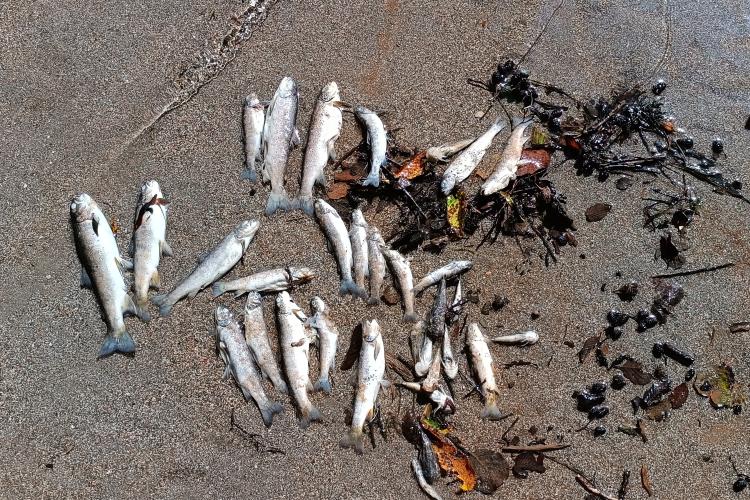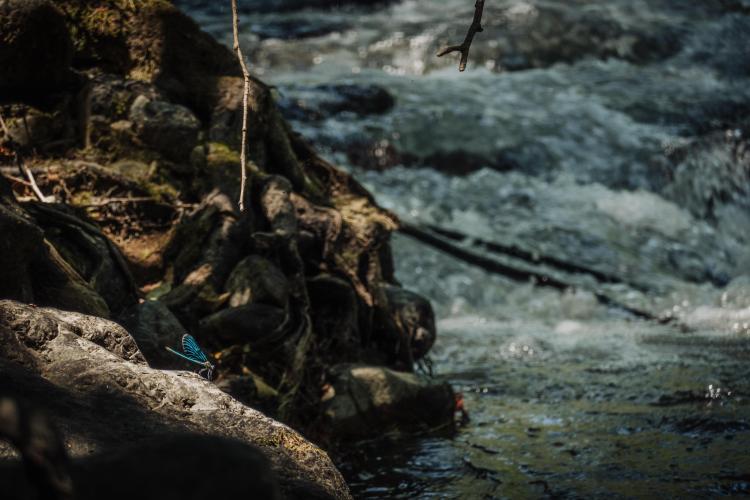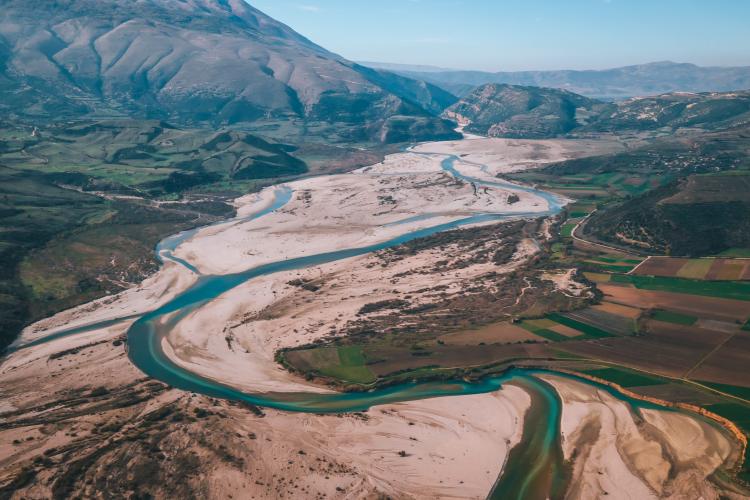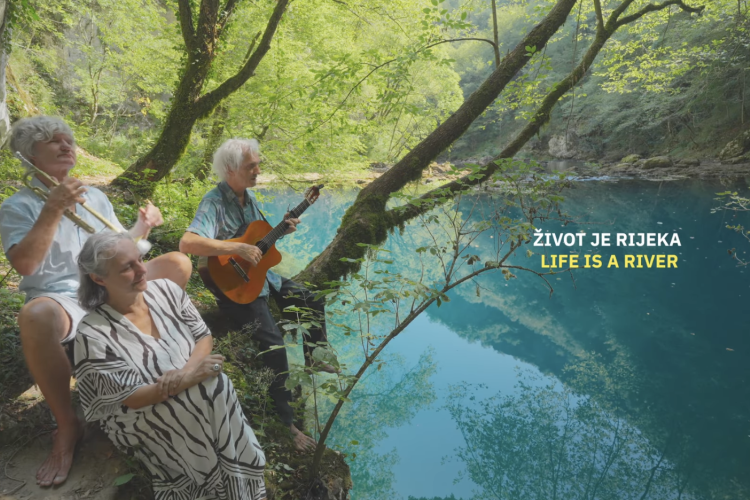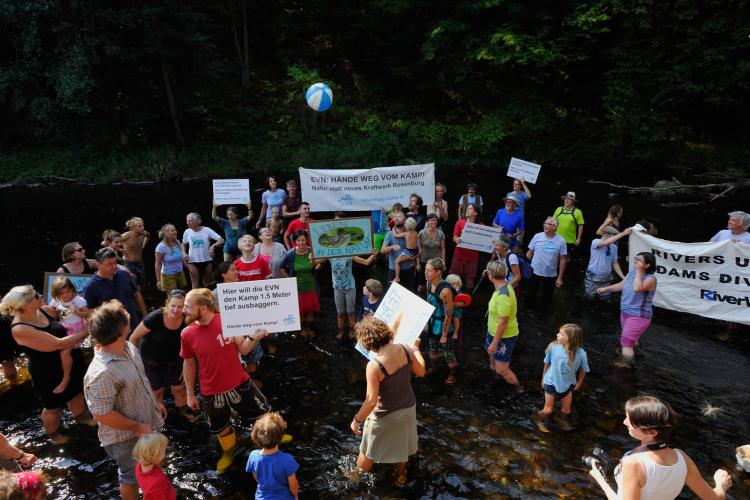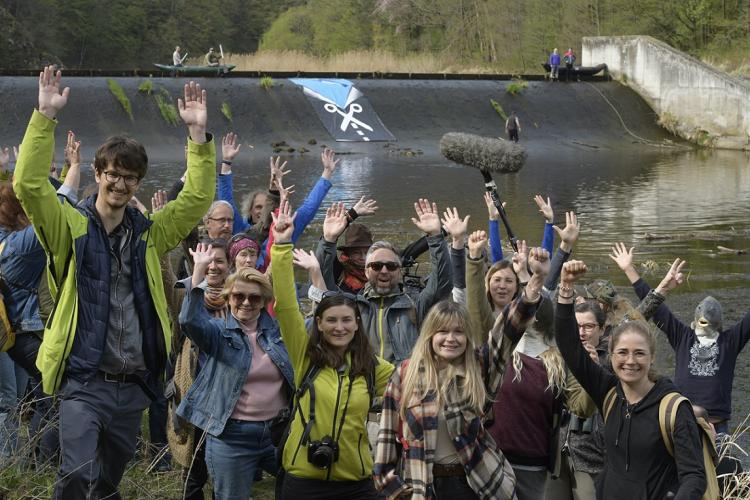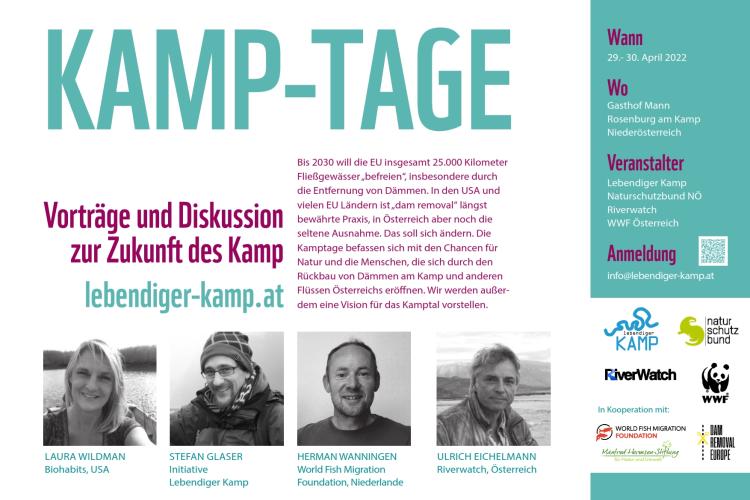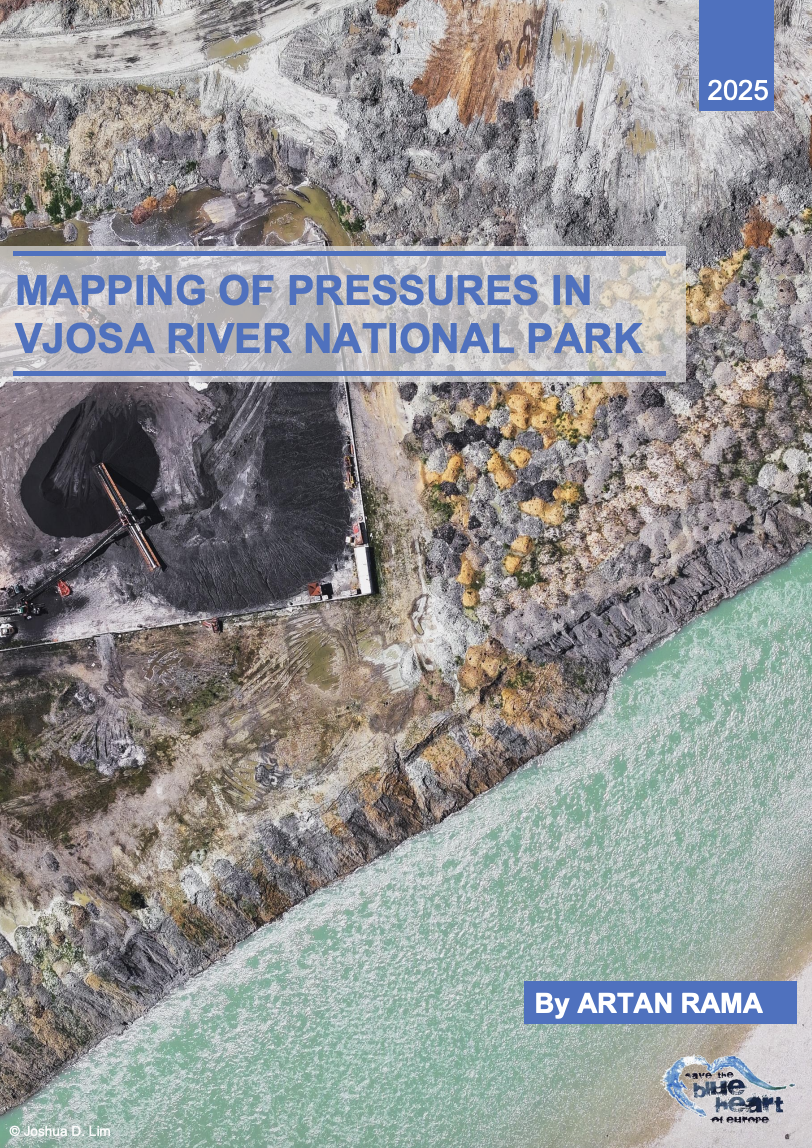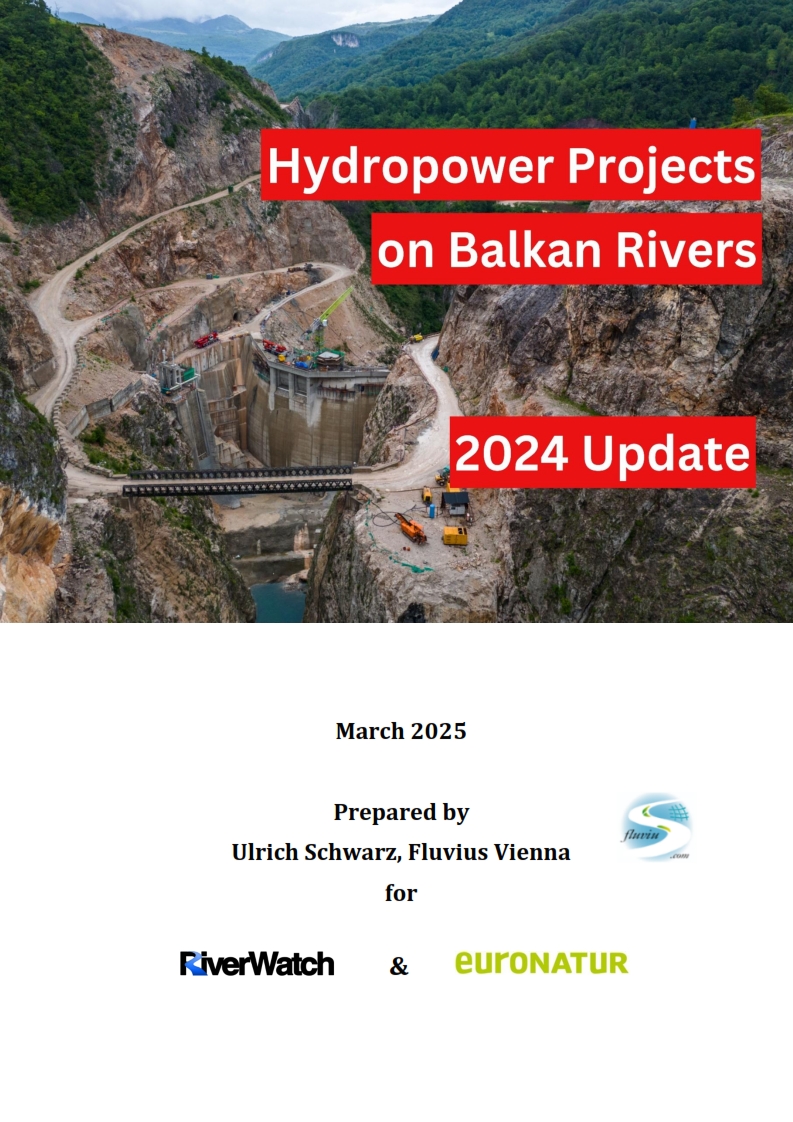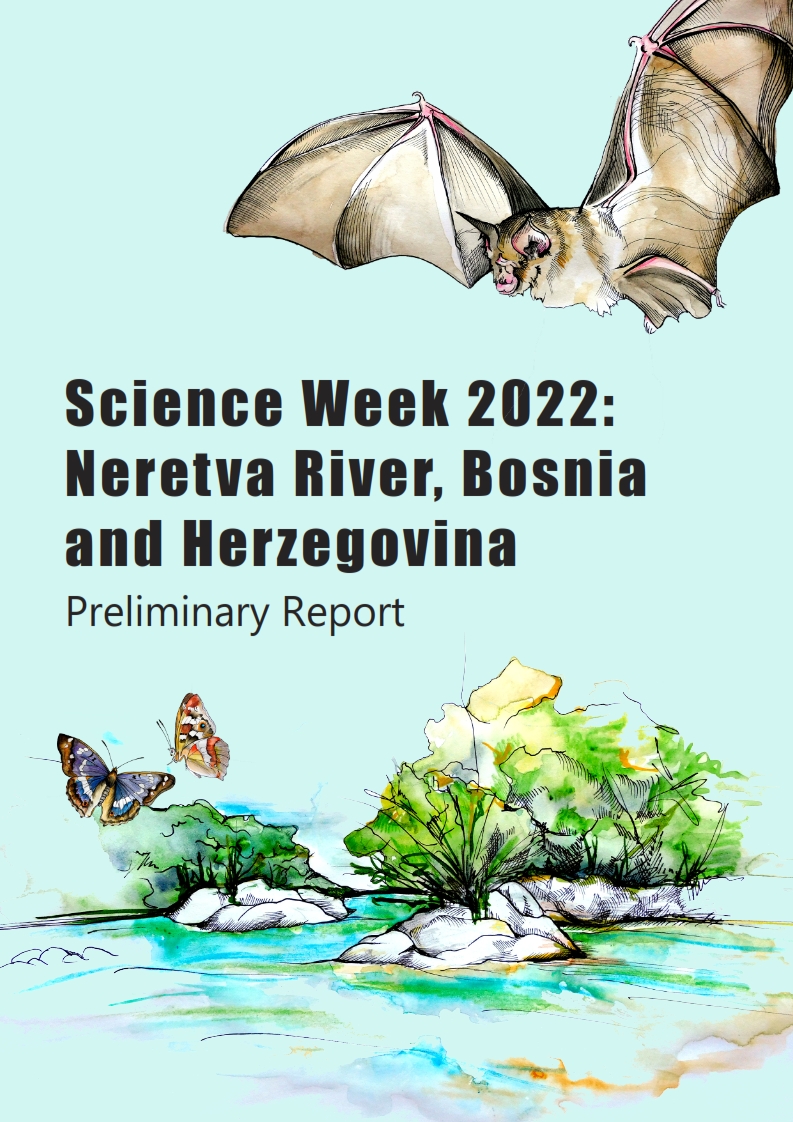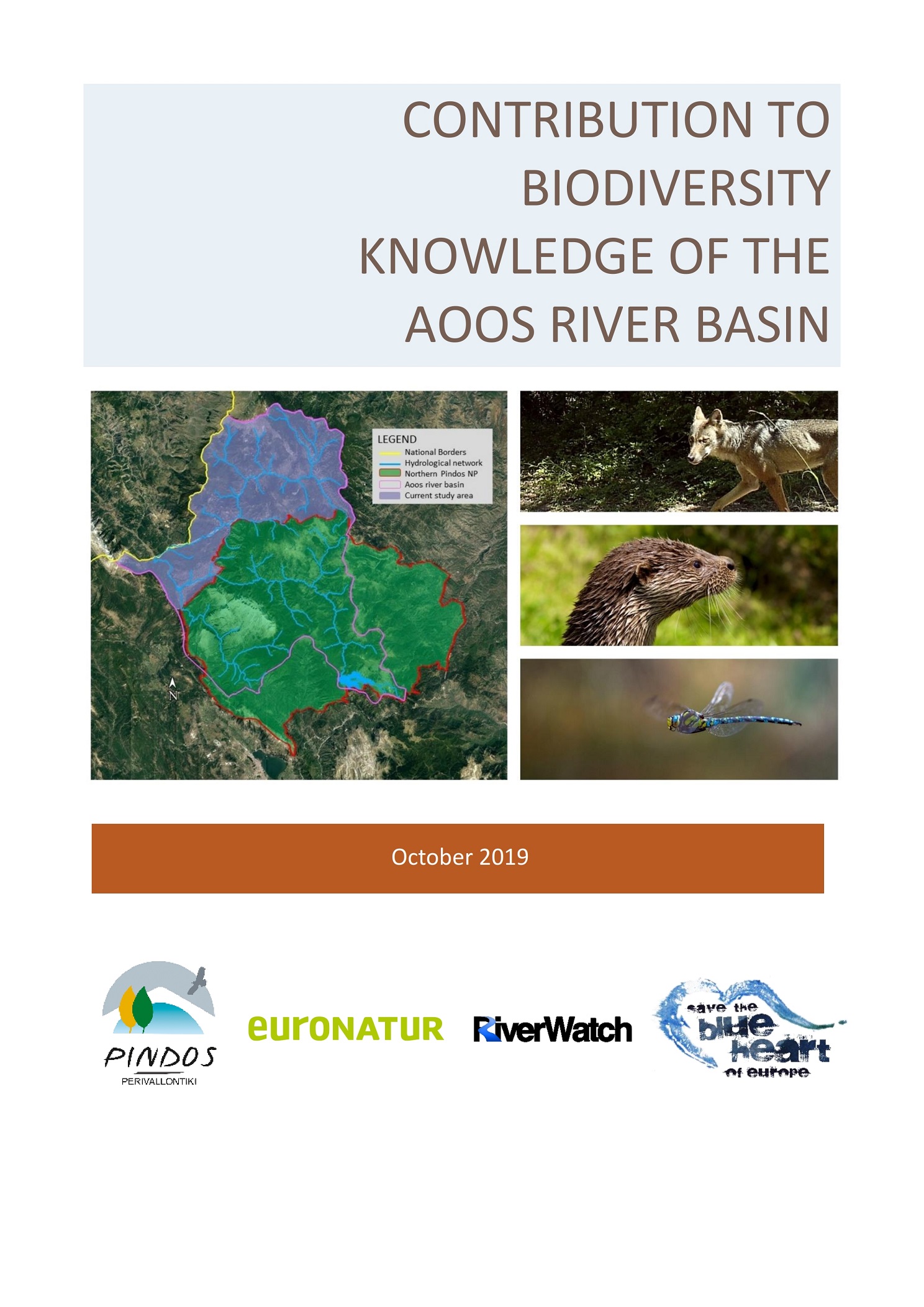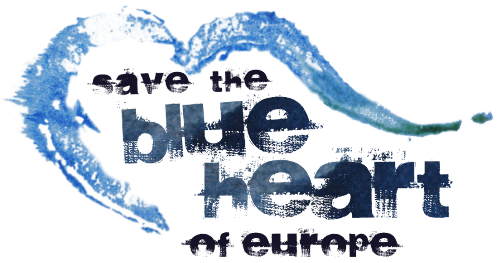Mapping of pressures in Vjosa Wild River National Park
This report highlights the ongoing threats to the Vjosa River and its tributaries, mapping out the pressures that are severely impacting the park’s biodiversity and pristine environment. The report analyses pressures from the extractive industry, urban activity, irrigation, and tourism, but highlights three main categories of concern:
- Extraction: Water extraction for irrigation, urban supply, and industrial use is a major issue. Irrigation practices, carried out through irrigation channels based on the data collected, cover at least an area of 47,266 hectares, reducing natural flow and negatively affecting aquatic and terrestrial habitats.Water
- Gravel Extraction: Intensive gravel extraction, with 36 plants identified along the river, of which 17 are active, 5 inactive, 5 abandoned, and only 2 rehabilitated. These activities have damaged the river’s morphology, natural habitats, and water quality.
- Extractive and Processing Industry: Industrial activities include the extraction of oil, bitumen, limestone, and other minerals. The most affected area is Selenica, with 13 active mines and over 150 oil wells impacting the quality of water and surrounding soils.
The report emphasises the importance of immediate measures to reduce the negative impacts of these activities on the Vjosa Wild River National Park.
Full report: Mapping of pressures in Vjosa Wild River National Park
Hydropower Projects on Balkan Rivers 2024 Update
Every two years, we analyse the situation of hydropower development in the Balkans, updating the data on existing and planned hydropower plants (HPPs) as well as those currently under construction. Moreover, we assess how many of these projects are located in protected areas. Since the last update in 2022, 110 HPPs have come into operation, leaving another 1,100 river kilometres devastated. The 2024 data update found that 3,188 HPPs are planned in the region, 94 are currently under construction, and 1,836 are operational; 92% of the planned projects are small HPPs (less than 10 MW); and almost half of the projects are planned or under construction within protected areas.
A comparison of the data since 2015 shows that we succeeded in slowing down the dam tsunami. Furthermore, the number of projects under implementation has steadily decreased since 2017. This success is also reflected in the suspension of 452 HPPs, which are no longer considered feasible for implementation. Notably, these include 26 HPPs in the Vjosa Wild River National Park in Albania, fifteen projects along the Neretvica River in BiH, and 405 projects in Greece. In BiH, additional suspensions are expected following recent changes to the Law on Electricity in the Federation of Bosnia & Herzegovina, leading to the suspension of at least 116 projects.
FULL STUDY: Hydropower Projects on Balkan Rivers 2024 Update
Vjosa Wild River National Park Research Plan
The Vjosa Wild River National Park (VWRNP) research plan is a ten-year initiative dedicated to understanding and protecting one of Europe's last large free-flowing rivers. This comprehensive plan aims to coordinate scientific efforts that will guide sustainable park management while contributing to global knowledge of natural river systems.
Key research areas include monitoring and data collection, understanding natural river processes, conserving species and habitats, and sustainable development. A core research team will work alongside local and international experts, ensuring that scientific findings directly inform policy decisions and park management. The plan also prioritises public engagement, with accessible data-sharing and citizen science initiatives to foster community involvement. Through these efforts, the VWRNP aims to serve as a model for river conservation and sustainable management across Europe.
Full study: Vjosa Wild River National Park Research Plan
Distribution and spawning activity of the Danube salmon (Hucho hucho) in the Upper Drina River
 This study examines the endangered Danube salmon, or huchen, which is unique to the Danube River basin and faces severe threats, particularly in the Balkans, once the species' last stronghold. However, even in the Balkan rivers, the huchen has now lost much of its distribution area. With the remaining huchen habitat largely restricted to Balkan rivers like the Drina and Tara, this study focuses on determining the current population status and identifying breeding grounds in the upper Drina basin. Major threats include pollution, hydropower development, and overfishing, yet restoration opportunities are possible with targeted conservation efforts.
This study examines the endangered Danube salmon, or huchen, which is unique to the Danube River basin and faces severe threats, particularly in the Balkans, once the species' last stronghold. However, even in the Balkan rivers, the huchen has now lost much of its distribution area. With the remaining huchen habitat largely restricted to Balkan rivers like the Drina and Tara, this study focuses on determining the current population status and identifying breeding grounds in the upper Drina basin. Major threats include pollution, hydropower development, and overfishing, yet restoration opportunities are possible with targeted conservation efforts.
Natural values and biodiversity of the Vjosa Delta - current situation and threats
 The Vjosa Delta in Albania, covering about 240 km², is one of the Adriatic's last untouched transitional ecosystems, home to rich biodiversity, including rare species and key habitats. However, large-scale tourism and infrastructure projects, like the Vlora International Airport, threaten the ecological integrity of this protected landscape. Two recent Scientific Weeks brought together local and international experts to document the delta's biodiversity, vulnerabilities, and the need for sustainable management.
The Vjosa Delta in Albania, covering about 240 km², is one of the Adriatic's last untouched transitional ecosystems, home to rich biodiversity, including rare species and key habitats. However, large-scale tourism and infrastructure projects, like the Vlora International Airport, threaten the ecological integrity of this protected landscape. Two recent Scientific Weeks brought together local and international experts to document the delta's biodiversity, vulnerabilities, and the need for sustainable management.
This study explores the Vjosa Delta's ecological richness, focusing on detailed data about biodiversity, habitat types, and environmental pressures. It examines 18 Natura 2000 habitats, including rare and endangered species such as birds, fish, and plants. The data also cover geographic and landscape features, as well as ecosystem sensitivities and threats. This includes specifics on aquatic and terrestrial flora and fauna, invertebrates, amphibians, reptiles, birds, and mammals. Additionally, the research highlights the human impacts on these habitats and presents insights into best conservation practices from across the Mediterranean.
The study calls for preserving the Vjosa Delta through ecotourism, and it advocates for National Park status for comprehensive protection.
Are Balkan Countries Safeguarding Their Rivers? - A Legal Analysis
This report provides an interim evaluation of the extent to which the Western Balkan countries of Albania, Bosnia and Herzegovina, Kosovo, Montenegro, the Republic of North Macedonia and Serbia are protecting their rivers by transposing and implementing key EU directives relevant to hydropower projects.
Following a comprehensive legal analysis, the authors conclude that although the six states, all of which are striving for EU membership, have made some progress in transposing binding EU Directives into national legislation, there are still serious systematic shortcomings to comply with the EU environmental legal framework. This can be observed for instance in the poor quality of environmental impact assessments (EIAs) for many hydropower projects, such as those on Vjosa in Albania or Komarnica in Montenegro. Another significant problem is the lack of political will to effectively enforce existing laws.
By providing detailed recommendations on how to address these systematic failures, the report serves as a practical guide for decision-makers and nature conservation organizations.
This publication was produced by Client Earth in cooperation with EuroNatur and Riverwatch.
Full Report: Are Balkan Countries Safeguarding Their Rivers? - A Legal Analysis
Executive Summary: Are Balkan Countries Safeguarding Their Rivers? - A Legal Analysis
Mediterranean Deltas – Assessment of general intactness
 River Deltas are intricate landscapes shaped by nature over millennia. Yet, they're in crisis. Changes in land use driven by agriculture and industry have reshaped these ecosystems. This study dives into Mediterranean deltas, revealing the urgent need for conservation.
River Deltas are intricate landscapes shaped by nature over millennia. Yet, they're in crisis. Changes in land use driven by agriculture and industry have reshaped these ecosystems. This study dives into Mediterranean deltas, revealing the urgent need for conservation.
Conducted by Ulrich Schwarz from FLUVIUS Floodplain Ecology and River Basin Management in Vienna, Austria, 258 deltas and river mouths in the Mediterranean Sea have undergone assessment. Shockingly, a mere 4% of these vital ecosystems remain in their pristine, untouched state today. Among these precious few, the delta of the Vjosa and the neighboring deltas of the Shkumini and Semani rivers in Albania stand out. Together, they constitute the last large pristine deltas, holding unparalleled significance for the entire Mediterranean Sea and Europe as a whole.
The study examines sediment flux, showing dams disrupting natural sediment transport. But amidst degradation, there's hope. The findings call for action to conserve deltas from Albania to Montenegro, each holding a story of resilience and adaptation in the face of adversity.
Full Study: Mediterranean Deltas – Assessment of general intactness
Neretva Science Week 2023 – Preliminary Report
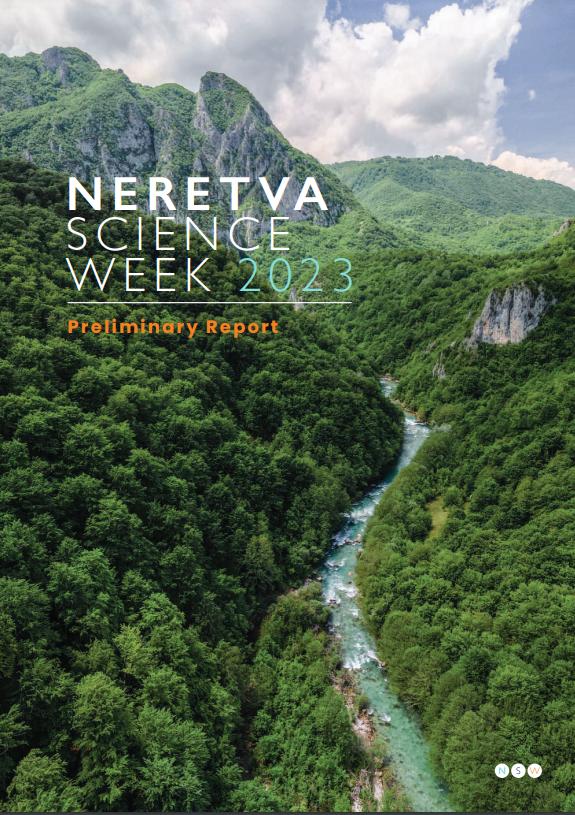 Neretva Science Week 2023 took place from May 30th to June 7th. A diverse team of 62 scientists from 17 countries gathered in small town Ulog, to contribute to the conservation of the Neretva river system. They were accompanied by journalists, photographers, activists, and artists. Various independent teams explored different areas on and around the river, to get a deeper understanding of specific habitats, point to threatened places and integrate across terrestrial and aquatic habitats.
Neretva Science Week 2023 took place from May 30th to June 7th. A diverse team of 62 scientists from 17 countries gathered in small town Ulog, to contribute to the conservation of the Neretva river system. They were accompanied by journalists, photographers, activists, and artists. Various independent teams explored different areas on and around the river, to get a deeper understanding of specific habitats, point to threatened places and integrate across terrestrial and aquatic habitats.
Scientists studied over 15 groups of animals and plants. They explored fish, aquatic macroinvertebrates, birds, amphibians, reptiles, large mammals, bats, subterranean fauna, soil invertebrates, dragonflies, spiders, aquatic beetles, moths, butterflies, grasshoppers and crickets. We also had a strong team of botanists, dendrochronologists and specialists for mosses and fungi. Finally, a socio-cultural team studied the social values of the Neretva, what the river means to locals and also to scientists: they explored the motivation and drivers behind our conservation efforts.
Here, we gathered the preliminary results of Neretva Science Week 2023, covering 19 studies or fields of expertise. They reflect the enthusiasm of involved scientists as well as convey an impression of the extraordinary value of the Upper Neretva River and Valley.
Neretva Science Week – Preliminary Report
Breeding Birds of Vjosa Wild River National Park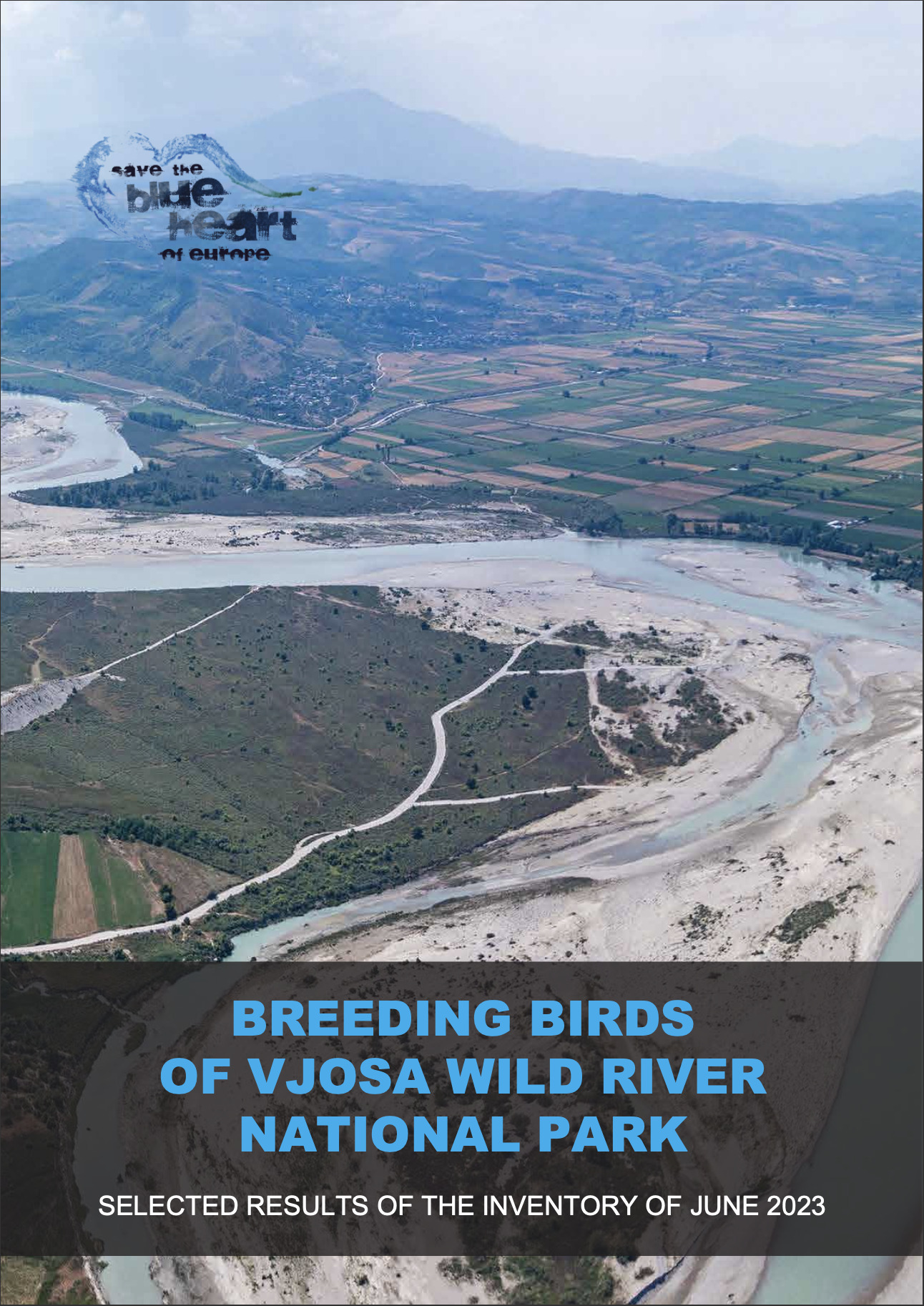
This is the first ever study about the distribution of breeding birds in the Vjosa Wild River National Park. In 2023, 92 different bird species were recorded within the boundaries of the park. Furthermore, the author of the study – Albanian Ornithological Society (AOS) – meticulously assessed the breeding populations of eleven pivotal species: Sand Martin, European Bee-eater, Comon Kingfisher, Stone Curlew, Little Ringed Plover, Common Sandpiper, Common Tern, Little Tern, Black stork, Egyptian vulture, and European Roller. This data provides the basis for a future management concept of the national park.
Full Study: Breeding Birds of Vjosa Wild River National Park
Vjosa Reforestation Study
The Vjosa valley is – similar to many regions in Albania – to a large extend deforested. This leads not only to ecological deficits, but also to an increase in erosion, especially at the slopes, resulting in an increasing flood risk. This pilot study provides a general overview of the forest situation in the Vjosa basin, discusses problems and defines areas where pilot reforestation projects are to be implemented soon.
The study was carried out by the Institute of Silviculture of the University of Natural Resources and Life Sciences Vienna in cooperation with the Faculty of Forest Sciences, Agricultural University of Tirana
Full Study: The Forest in the Vjosa River basin: an assessment of the situation
Hydropower projects on Balkan Rivers: 2022 Update
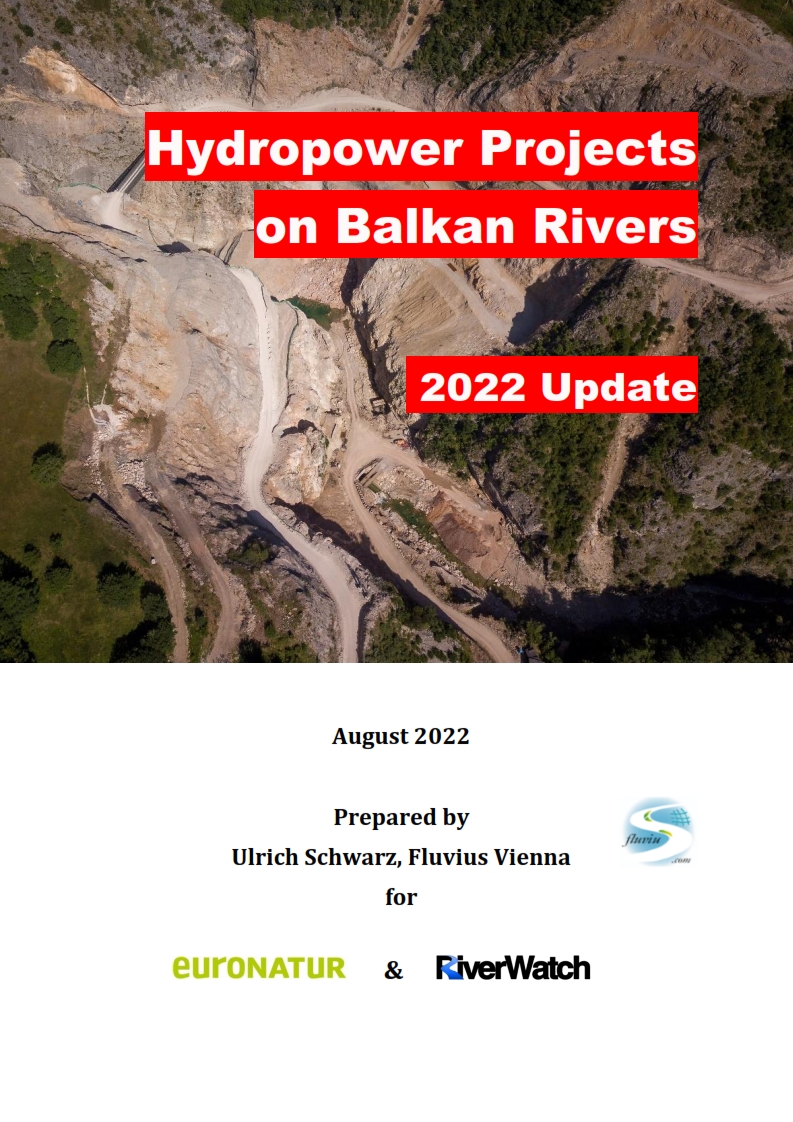 Every two years, we analyse the situation of hydropower development in the Balkans, updating the data of existing and planned hydropower plants as well as those currently under construction. Moreover, we assess how many of these projects are located in protected areas.
Every two years, we analyse the situation of hydropower development in the Balkans, updating the data of existing and planned hydropower plants as well as those currently under construction. Moreover, we assess how many of these projects are located in protected areas.
Since the last update of this kind in 2020, another 246 HPPs came into operation, leaving hundreds of kilometres of rivers and streams devastated. As of summer 2022, 3,281 hydropower plants (HPPs) are planned, 108 under construction and 1,726 are operational in the Balkans. 92% of the planned projects are small-scale dams. 50% of projects are planned or constructed inside existing and planned protected areas.
The good news: some positive signals have recently come from Bosnia and Hercegovina where the Federation adopted a new law restricting further development of SHPs (which means that 110 planned SHPs that are still listed in this data set can actually no longer be built), and from Albania, which has finally committed to establishing Vjosa River to European’s first Wild River National Park. After completion of this update, another 7 HPPS were revoked in the Shar Planina National Park in North Macedonia. These successes are the result of NGOs’ continuous fight for free-flowing rivers in the Balkans – and put great wind into their sails.
Hydropower projects on Balkan Rivers: 2022 Update
Updated Data in our interactive map
Neretva Science Week 2022 – Preliminary Report
From June 26th to July 5th, a diverse team of 48 scientists and 11 students from 7 countries visited the upper Neretva River to collect data aimed at characterising this pristine and highly threatened riverine ecosystem. They focused on describing aspects of river-associated biodiversity by combining their expertises on various aquatic and terrestrial plant and animal groups. Furthermore, they also studied the environmental conditions supporting this biodiversity and a selection of ecosystem functions it may drive in the particular setting of this river.
The purpose of this report is to provide some very preliminary impressions, highlights and an overview from each of the specialty groups of what was done during this impressively international and collaborative effort. The data collected will be analysed in much more detail over the next months and a more detailed final report is expected by the end of the year 2022.
Neretva Science Week – Preliminary Report
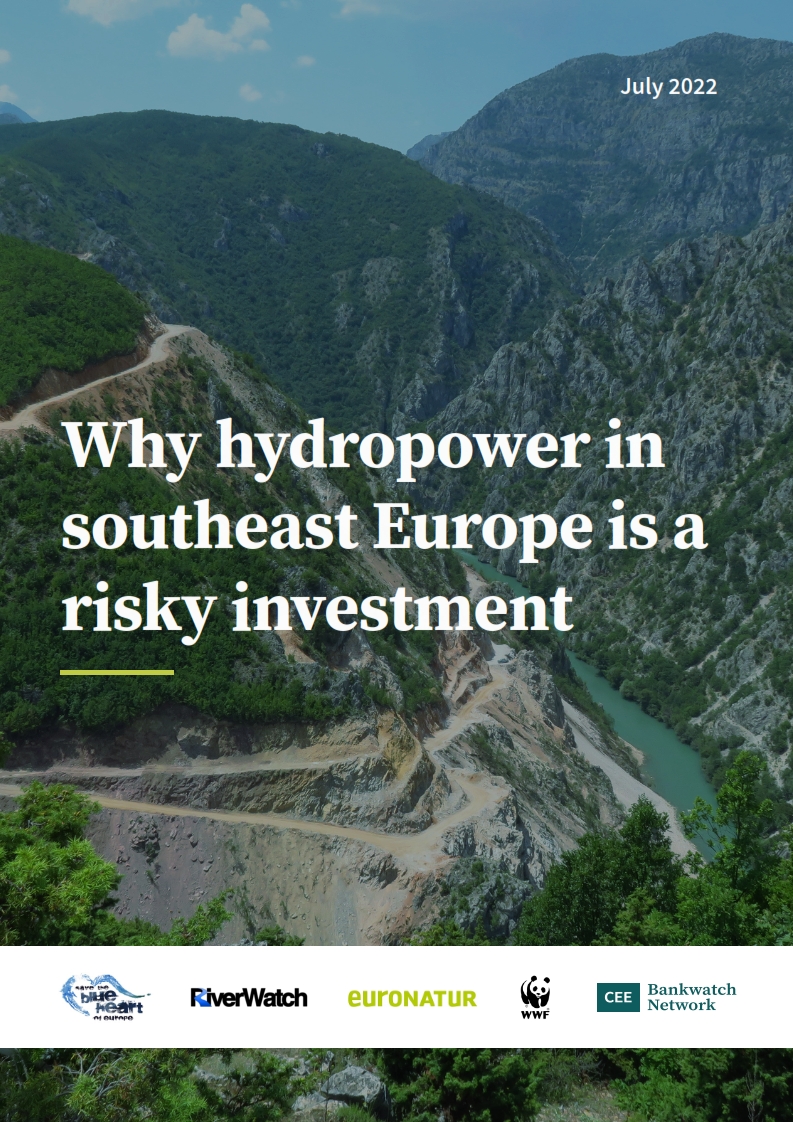 Why hydropower in southeast Europe is a risky investment
Why hydropower in southeast Europe is a risky investment
Greenfield large hydropower investments across southeast Europe face major risks and low realisation rates.
This report explains the risks behind hydropower projects in southeast Europe and shows that it will only get harder to build them in the future, due to climate vulnerability, the unique biodiversity, legal issues, public resistance and financing issues. It also recommends lower-risk investments that can help the region move towards a more environmentally, socially and economically sustainable energy system.
This publication was produced by CEE Bankwatch Network in cooperation with EuroNatur, Riverwatch and WWF Adria
Full Study: Why hydropower in southeast Europe is a risky investment
The Shushica River – Interdisciplinary exploration of the unique ecosystem
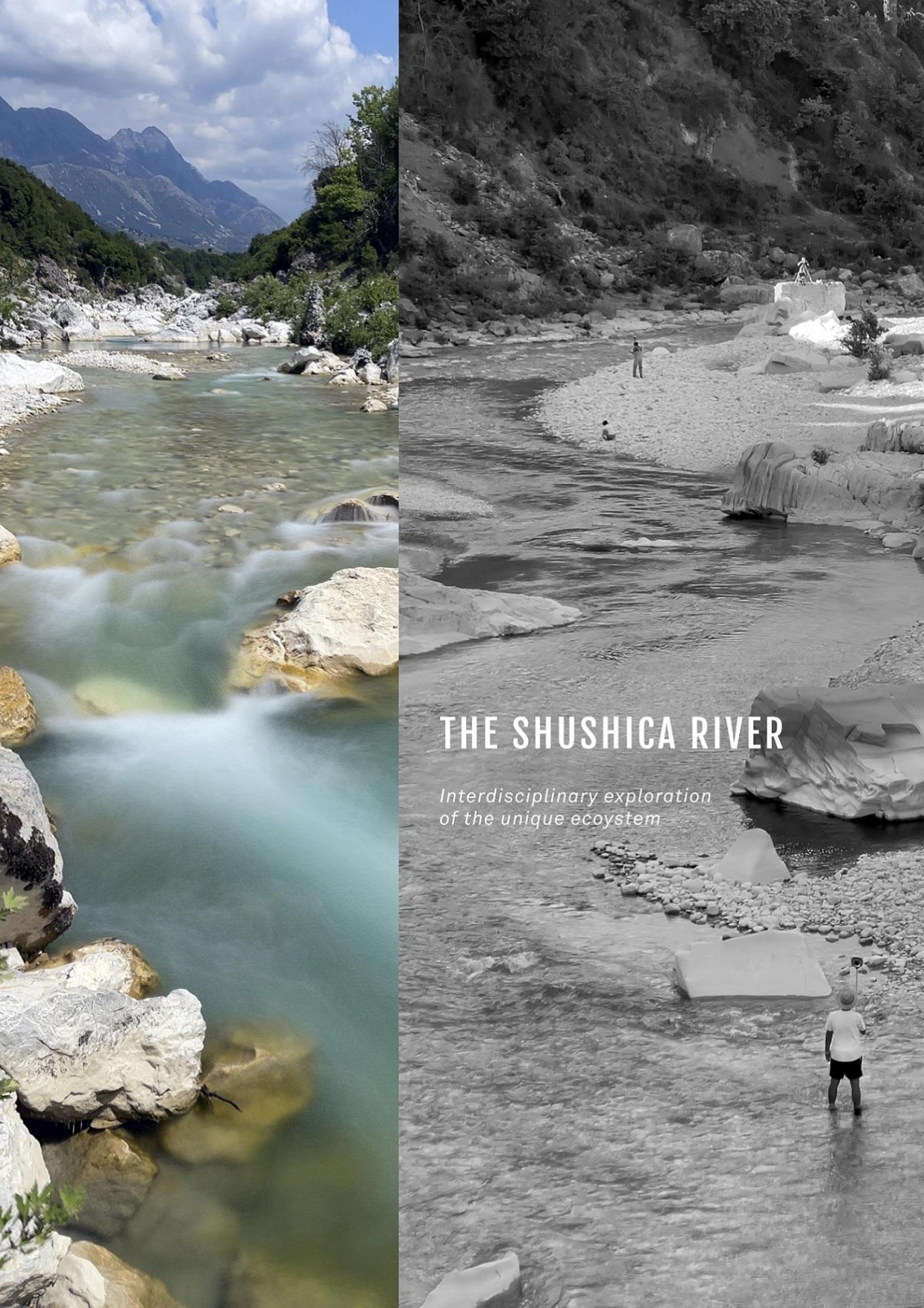 The Shushica in Albania is a tributary of the Vjosa and threatened by the planned construction of hydropower plants. Scientifically, the Shushica is a blank page and in order to close the knowledge gap, we brought 30 national and international scientists to the river in June 2021.
The Shushica in Albania is a tributary of the Vjosa and threatened by the planned construction of hydropower plants. Scientifically, the Shushica is a blank page and in order to close the knowledge gap, we brought 30 national and international scientists to the river in June 2021.
This preliminary report proves the high conservation value of the Shushica as an essential branch of the Vjosa river system. Due to the high habitat diversity, the Shushica hosts highly specific and endangered fauna and flora. Within the short collection period and at this preliminary stage of assessment, three aquatic insect and mollusc species were found that are new to science, several species new to Albanian and several species listed on the Red List of endangered species. The Shushica is also a hotspot for riparian-terrestrial and fish fauna.
The scientists detect potential violation of international and national law by the blockage of migration routes b the planned dams. They recommend a comprehensive long-term study and announce a detailed interdisciplinary analysis from spring 2022 until 2025.
The Shushica River – Interdisciplinary exploration of the unique ecosystem
Cutting hydropower subsidies – how are the Western Balkans doing?
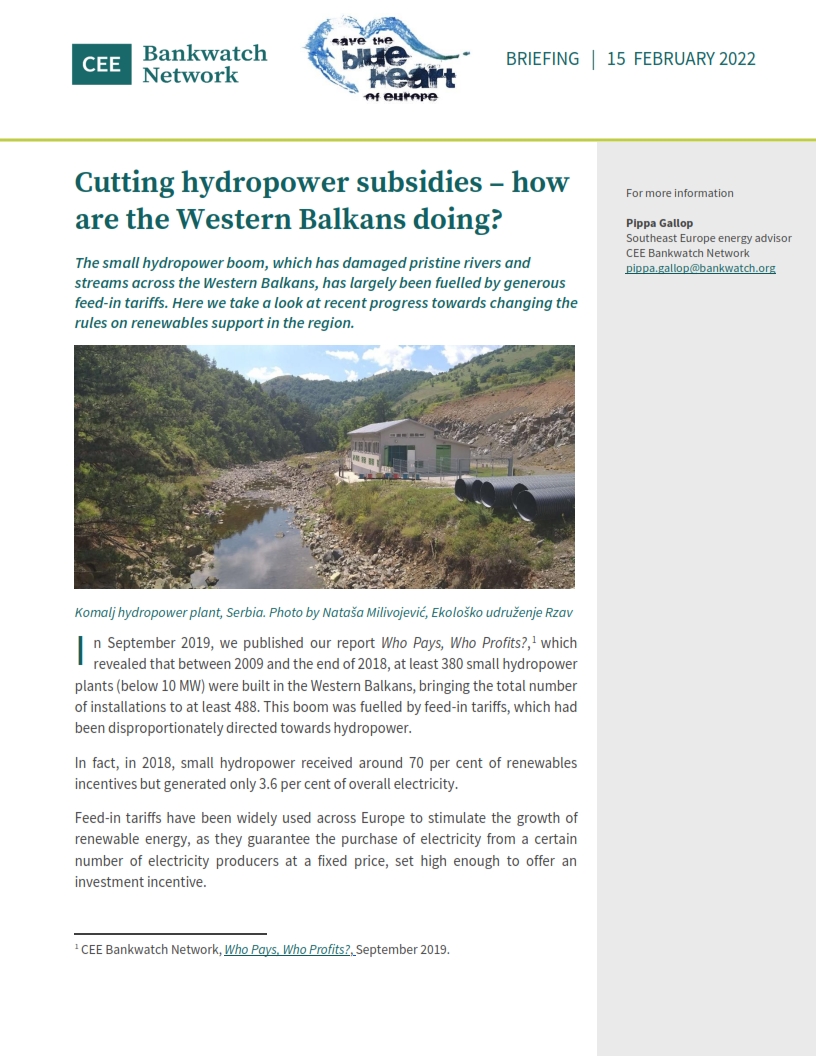 Feed-in tariffs have been widely used across Europe to stimulate the growth of renewable energy. The small hydropower boom, which has damaged pristine rivers and streams across the Western Balkans, has largely been fueled by generous feed-in tariffs. In fact, in 2018, small hydropower received around 70% of renewables incentives but generated only 3.6% of overall electricity.
Feed-in tariffs have been widely used across Europe to stimulate the growth of renewable energy. The small hydropower boom, which has damaged pristine rivers and streams across the Western Balkans, has largely been fueled by generous feed-in tariffs. In fact, in 2018, small hydropower received around 70% of renewables incentives but generated only 3.6% of overall electricity.
Progress in the last year towards more efficient and environmentally acceptable renewable energy policies in the Balkan region has been mixed. Across the region, great progress is being made in stopping small hydropower plants from infesting pristine rivers and streams, but faster action has to be taken to stop using public money to support them. We can no longer afford to waste public funds on damaging and climate-vulnerable energy sources like hydropower.
This briefing highlights the recent progress towards changing the rules on renewable energy support in Albania, Bosnia and Herzegovina, Kosovo, Montenegro and Serbia. It was produced by CEE Bankwatch Network in the frame of the Save the Blue Heart of Europe campaign, with financial support from MAVA Foundation.
Cutting hydropower subsidies – how are the Western Balkans doing? – Full briefing
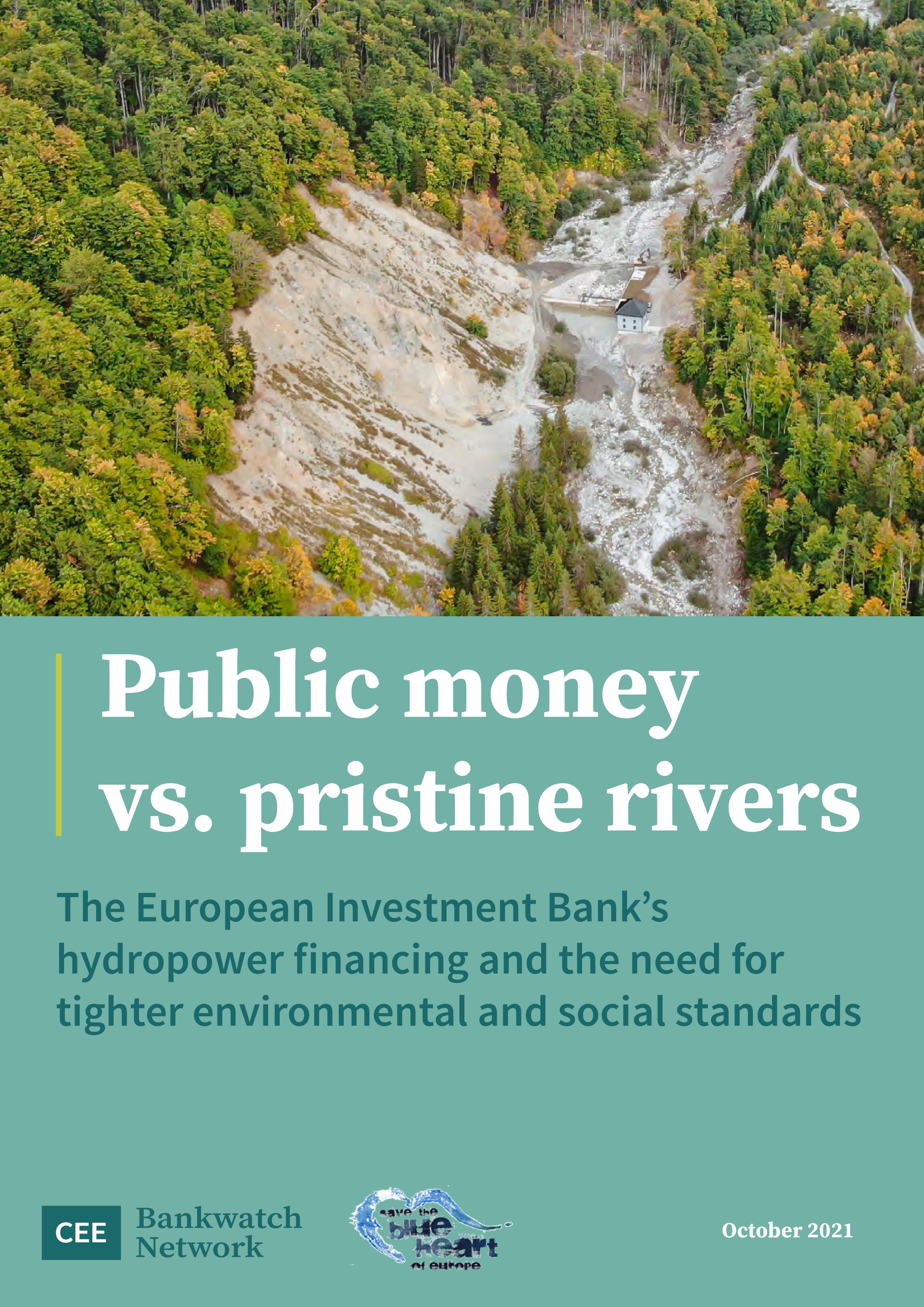 Public money vs. pristine rivers
Public money vs. pristine rivers
As the European Investment Bank revises its Environmental and Social Standards, this report presents eight hydropower schemes in central and eastern Europe either financed or under consideration by the Bank.
The projects – some financed directly and others via intermediaries such as commercial banks – show an urgent need for the Bank’s draft rules on biodiversity, financial intermediaries and Indigenous Peoples to be tightened up and provides concrete recommendations on how to do so.
This publication was produced by CEE Bankwatch Network in the frame of the Save the Blue Heart of Europe campaign, with financial support from MAVA Foundation.
Public money vs. pristine rivers - Full Study
Sava.Restore - Connecting the floodplains for healthy alluvial forest
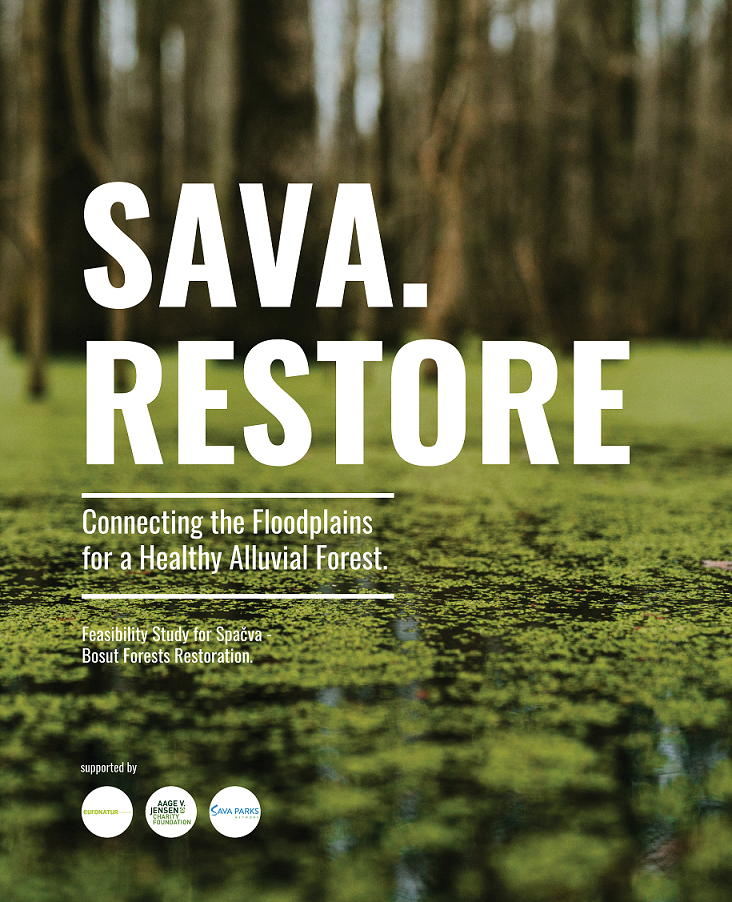 The river Sava, with a length of 926 km and a catchment area of over 97,800 km², the largest tributary of the Danube by discharge, is an outstanding ecological corridor connecting several Balkan countries and protected areas along it course.
The river Sava, with a length of 926 km and a catchment area of over 97,800 km², the largest tributary of the Danube by discharge, is an outstanding ecological corridor connecting several Balkan countries and protected areas along it course.
In the frame of the project “Sava Parks II - Freedom for Sava”, two feasibility studies for potential restoration and revitalization options along Sava River have been carried out, based on knowledge derived from the Sava Whitebook.
This feasibility study covers the Sava river stretch near the Bosut Forest (Serbia) and Spacva Forest (Croatia). The concept of this study foresees to provide an ecological floodplain restoration plan and promotes the idea of integrated land use and forest management. Here, the conceptualization of scenarios for an optimal flooding regime have been the main objective.
This study was conducted by E.C.O. Institute of Ecology (Austria).
Download the summary here: Sava.Restore - Connecting the floodplains for healthy alluvial forest
Sava River Restoration - from Brežice to Rugvica
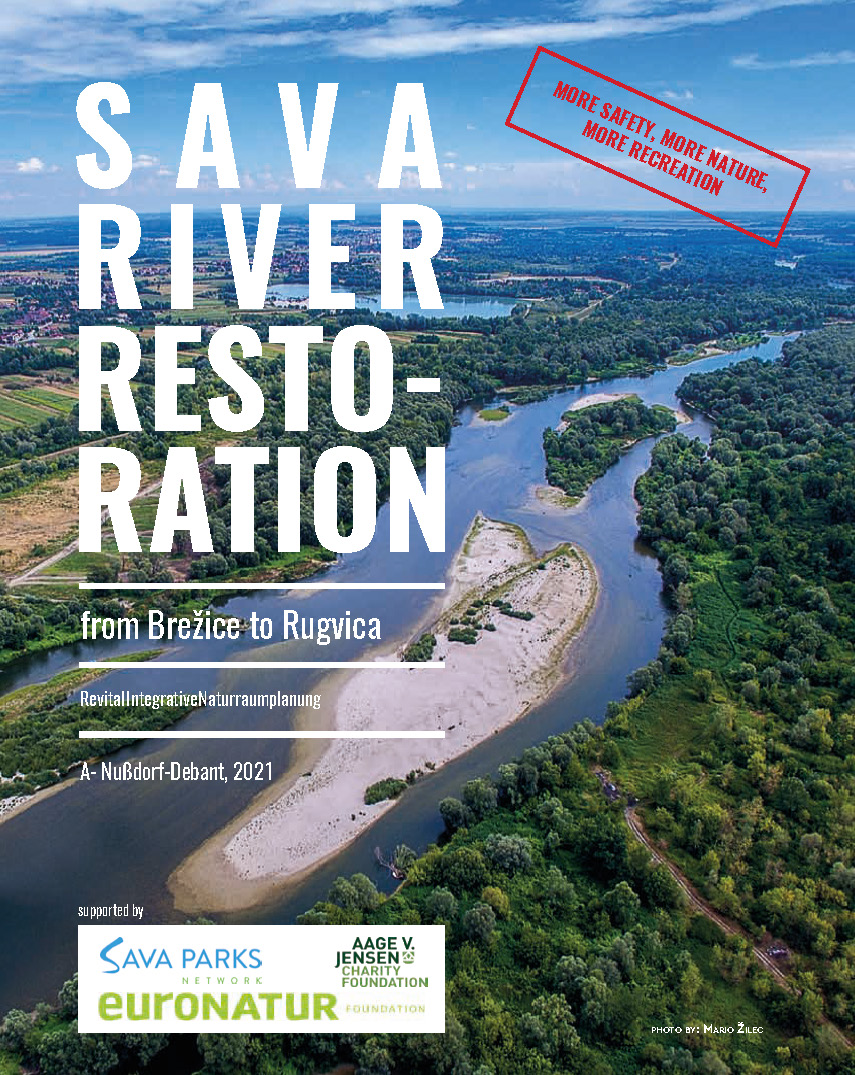 The river Sava, with a length of 926 km and a catchment area of over 97,800 km², the largest tributary of the Danube by discharge, is an outstanding ecological corridor connecting several Balkan countries and protected areas along it course.
The river Sava, with a length of 926 km and a catchment area of over 97,800 km², the largest tributary of the Danube by discharge, is an outstanding ecological corridor connecting several Balkan countries and protected areas along it course.
In the frame of the project “Sava Parks II - Freedom for Sava”, two feasibility studies for potential restoration and revitalization options along Sava River have been carried out, based on knowledge derived from the Sava Whitebook.
This feasibility study covers the Sava river stretch between Brežice (Slovenia) and Rugvica (Croatia). Moreover, the scope was extended by a small area around the derivation channel Sava-Odra, that is an important flood protection measure for the city of Zagreb.
The concept of this study foresees to provide a nature-based solution to current floodplain developments and promotes the idea of an ecological alternative to current spatial planning and challenges like river bed incision.
This study was conducted by REVITAL (Austria).
Download the summary here: Sava River Restoration - from Brežice to Rugvica
Sava River Restoration - from Brežice to Rugvica: Full Study
Social Impact of Hydropower: Quantitative Impact Assessment for the Balkan Countries
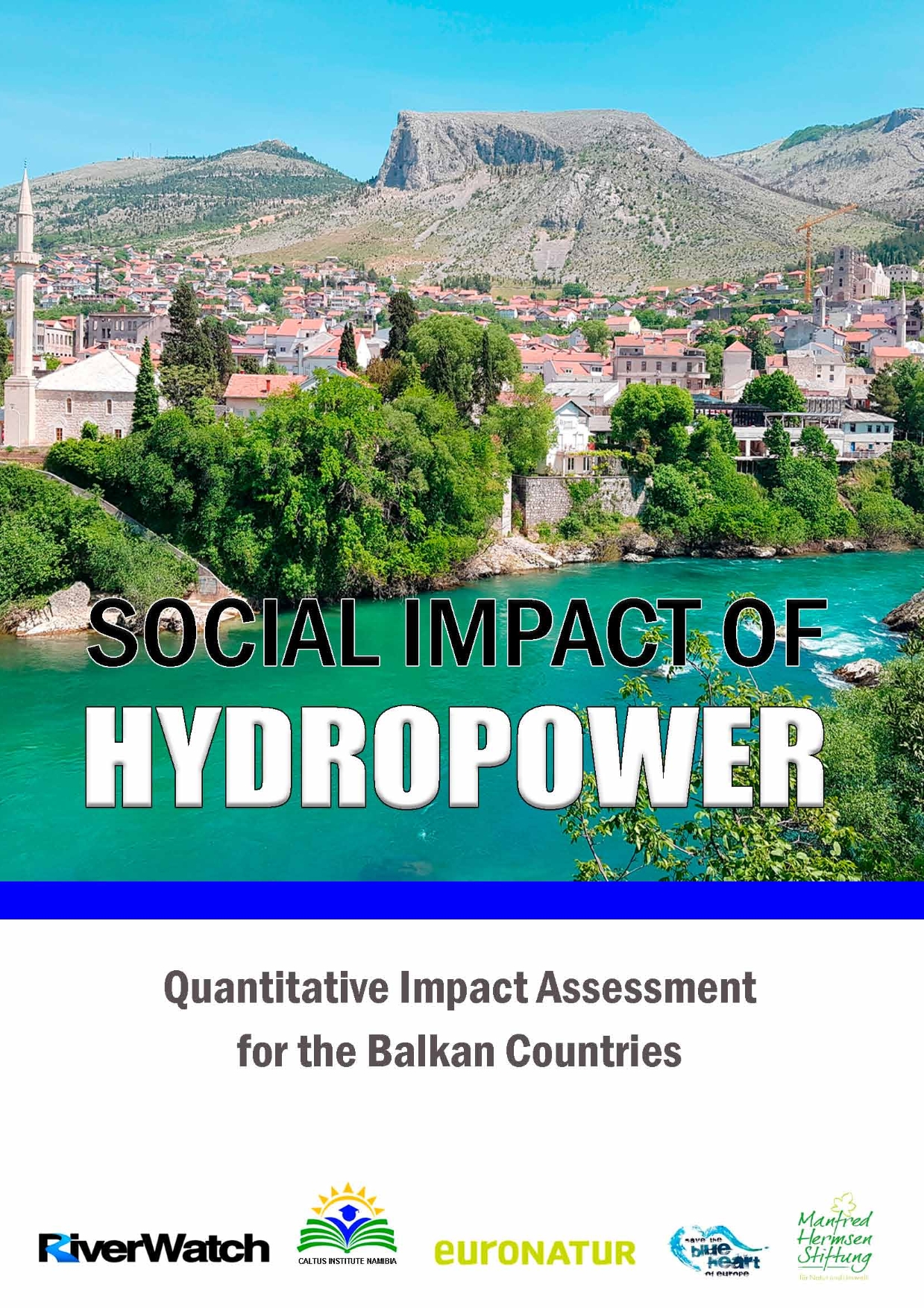 Hydropower plants and dams have detrimental effects on river ecosystems, but they also affect people in negative ways. This first-of-its-kind study on the social impacts of hydropower attempts to provide quantitative metrics of the number of people potentially affected by already operating, under construction and planned hydropower projects (HPPs) in the Balkan region.
Hydropower plants and dams have detrimental effects on river ecosystems, but they also affect people in negative ways. This first-of-its-kind study on the social impacts of hydropower attempts to provide quantitative metrics of the number of people potentially affected by already operating, under construction and planned hydropower projects (HPPs) in the Balkan region.
Using a newly developed "Social Impact Model", researchers from the CALTUS Institute Namibia calculated that in total, between 470,000 and 1.7 million people are affected by currently operating hydropower projects in Albania, Bosnia & Herzegovina, Bulgaria, Croatia, Northern Greece, Kosovo, Montenegro, North Macedonia, Serbia and Slovenia – depending on the distance at which they live from the affected river stretches. If all 3,400 HPPs currently planned and under construction in those countries would go into operation, this number would increase between 3 and 10 times. This means, that up to 11% of the 42 million inhabitants of the Balkan region may be affected by livelihood changes.
While large dams have long been controversial due to the massive human displacement they have already caused globally, the social impacts of smaller-scale hydropower projects, which are predominant in the Balkans, are mostly indirect, yet often cumulative. Thus, particularly in rural areas, development of small hydropower may lead to reduced agricultural productivity, pressure on agricultural and forest land, land degradation, or impacts on tourism potential and other income opportunities. Not to forget: the cultural value many people in the Balkans attach to rivers is also threatened.
Social Impact of Hydropower: Quantitative Impact Assessment for the Balkan Countries
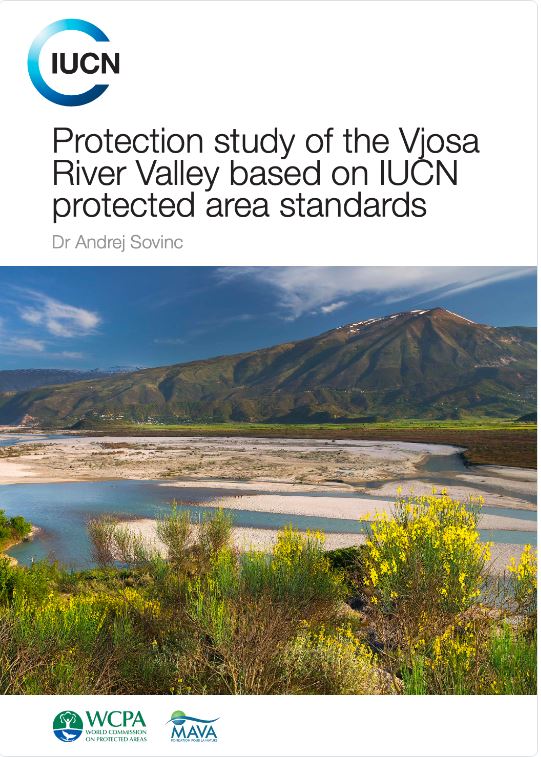 Protection study of the Vjosa River Valley based on IUCN protected area standards
Protection study of the Vjosa River Valley based on IUCN protected area standards
The IUCN has analysed the ecological and legal aspects around the Vjosa river. This study provides insight into the rationale and feasibility of declaring a protected area for the Vjosa Valley, along with the management objectives and associated protected area categories that would ensure the conservation of its key values. The study shows that a national park is the most appropriate option. The designation would help safeguard the biodiversity and traditional land use activities and support the green tourism development in southern Albania. Authored by Dr Andrej Sovinc, IUCN WCPA Regional Vice-Chair Europe, it is expected to assist the Albanian government to apply consistent protection under national legislation.
Full Study (English)
English Summary
Albanian Summary
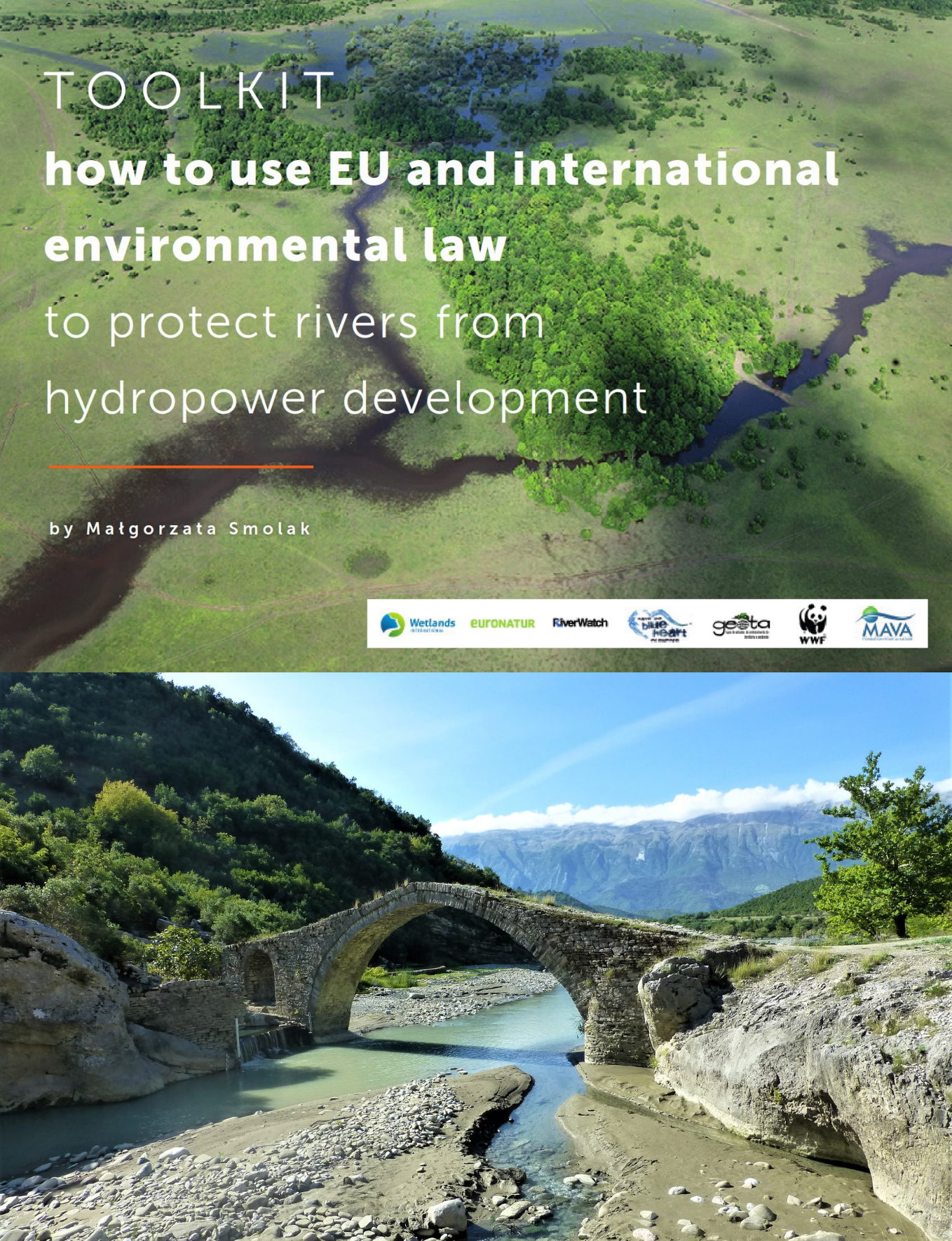 Legal Toolkit to protect rivers from hydropower development
Legal Toolkit to protect rivers from hydropower development
This Legal Toolkit provides guidance to activists and civil society organisations in navigating the possibilities for legal actions in river protection. The author, renowned Environmental and Energy Lawyer Malgorzata Smolak, offers readers with or without legal background an easy, accessible overview of the most relevant international laws and EU environmental regulations, which can be used to legally challenge new hydropower plants.
Read the “Toolkit on the use of EU and international environmental law to protect rivers from hydropower development” online or download the PDF.
The Legal Toolkit is a product of the Lawyers for Rivers Initiative launched in 2018 by EuroNatur, GEOTA, Riverwatch, Wetlands International European Association and WWF Adria.
The Vjosa River - A Baseline Study on Biodiversity, potential impacts, and legal framework for hydropower development
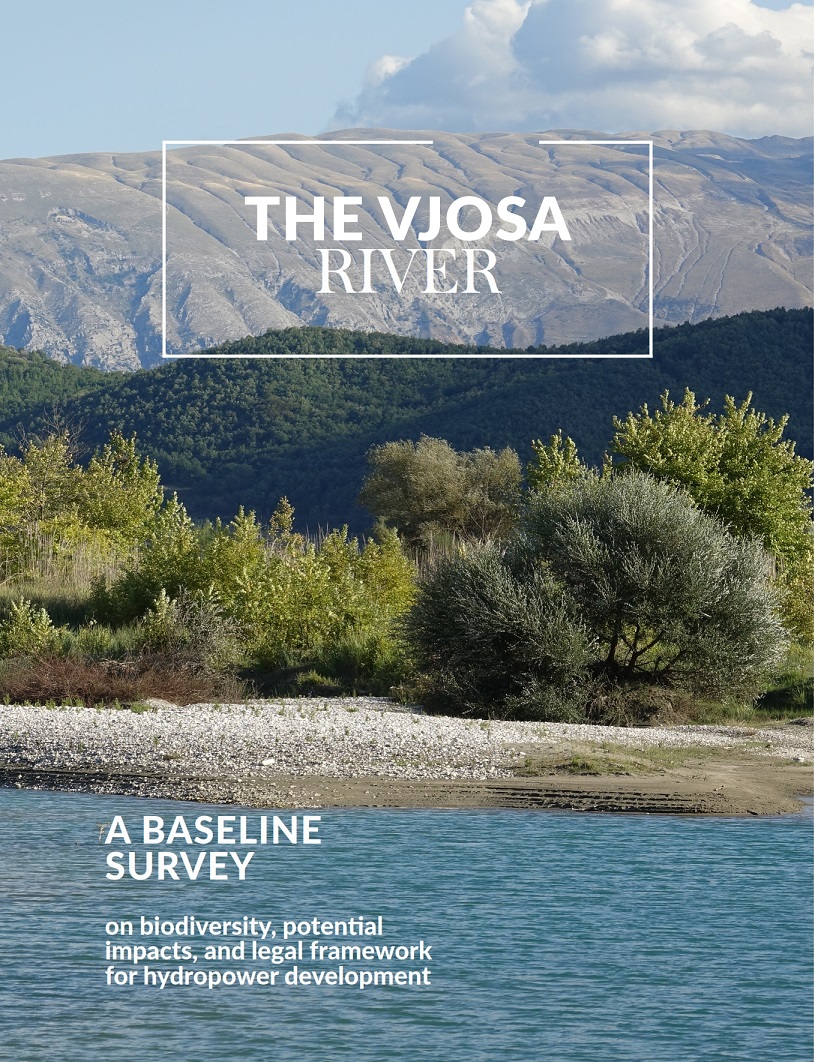 This baseline survey summarises the value of the Vjosa River system as one of the few remaining reference sites for dynamic floodplains in Europe on the one hand, and points out the detrimental effects dams could have on the river system on the other. Only one dam will significantly destroy the ecological continuum of a pristine river. Spearheaded by the University of Natural Resources and Life Sciences, Vienna, this study documents over 1100 species, including high numbers and vital populations of many protected and endangered species that are listed in national and international laws and conventions, highlighting the significance of this natural environment on an international scale. The actual number of species is likely to be much higher, as this survey was time-limited, revealing only snapshots.
This baseline survey summarises the value of the Vjosa River system as one of the few remaining reference sites for dynamic floodplains in Europe on the one hand, and points out the detrimental effects dams could have on the river system on the other. Only one dam will significantly destroy the ecological continuum of a pristine river. Spearheaded by the University of Natural Resources and Life Sciences, Vienna, this study documents over 1100 species, including high numbers and vital populations of many protected and endangered species that are listed in national and international laws and conventions, highlighting the significance of this natural environment on an international scale. The actual number of species is likely to be much higher, as this survey was time-limited, revealing only snapshots.
The study raises three main arguments against the proposed development of HPPs, such as the Kalivaç HPP, along the Vjosa River. The construction of the Kalivaç hydropower plant would
- cause severe biodiversity loss and local extinctions by cutting off 881km of rivers and streams of the total 1,109 km.
- Be in direct violation of signed laws, Directives and Conventions.
- Have high economic costs owing to sediment-related problems and loss of tourism.
Evaluating the energy contribution of small hydropower in the European Mediterranean Basin
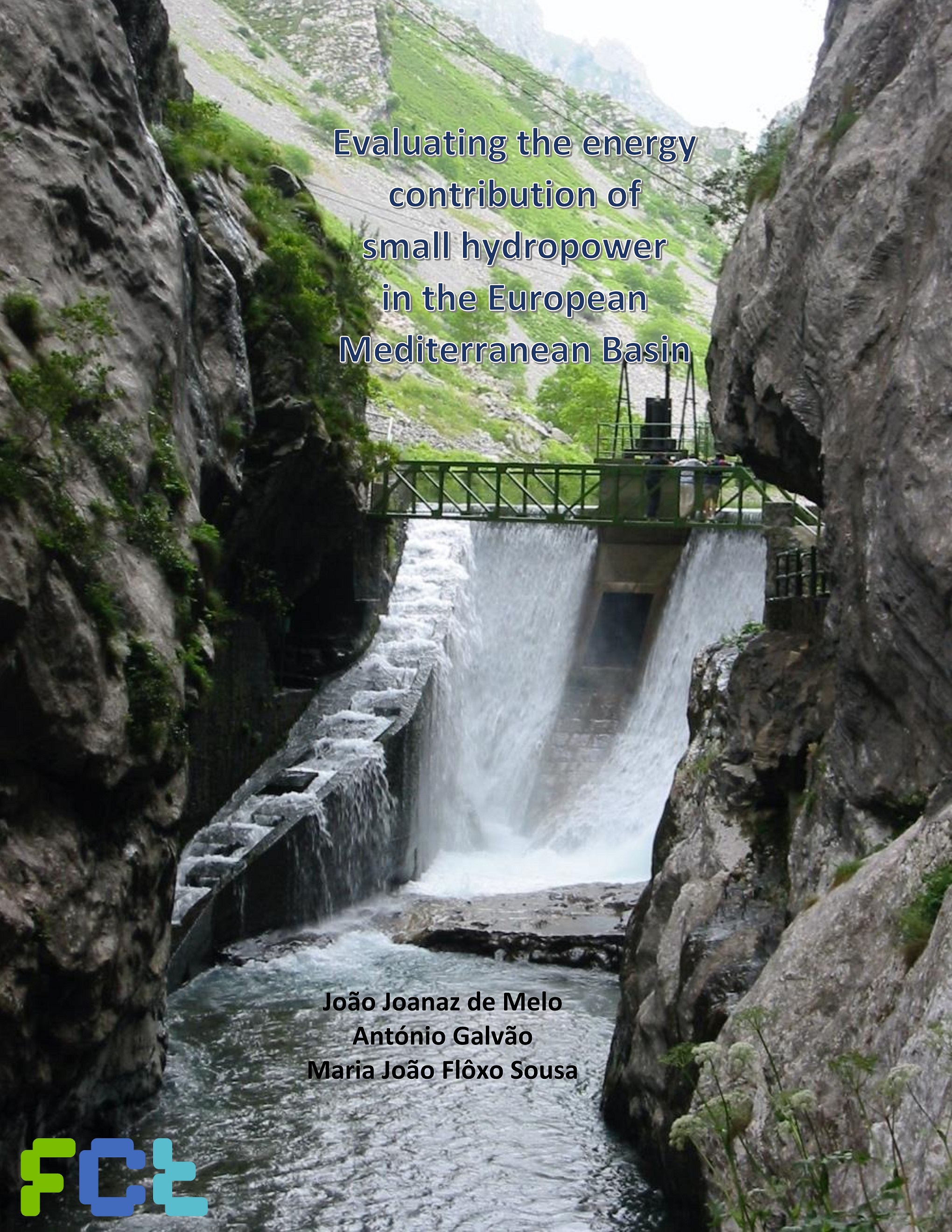 Small hydropower is widely promoted as a clean and green source of electricity which is indispensable for the renewable energy transition – despite growing evidence of its devastating effects on river ecosystems and its comparatively small energy contribution. This study by researchers at NOVA University Lisbon builds on an inventory of current and proposed small hydropower projects in the European Mediterranean, evaluating their economic viability in a climate change context and their significance for energy supply. The authors found that even when making an ambitious estimate, existing small hydropower projects can potentially cover at best 2.6% of gross electricity consumption and 0.47% of primary energy consumption. The real contribution is likely much lower. Building an additional 5,748 small hydropower installations (i.e. more than doubling the number of existing plants), would not increase the energy contribution of small hydro by much, especially under climate change conditions. Investments in energy efficiency and emerging technologies, such as photovoltaic, would be more cost effective.
Small hydropower is widely promoted as a clean and green source of electricity which is indispensable for the renewable energy transition – despite growing evidence of its devastating effects on river ecosystems and its comparatively small energy contribution. This study by researchers at NOVA University Lisbon builds on an inventory of current and proposed small hydropower projects in the European Mediterranean, evaluating their economic viability in a climate change context and their significance for energy supply. The authors found that even when making an ambitious estimate, existing small hydropower projects can potentially cover at best 2.6% of gross electricity consumption and 0.47% of primary energy consumption. The real contribution is likely much lower. Building an additional 5,748 small hydropower installations (i.e. more than doubling the number of existing plants), would not increase the energy contribution of small hydro by much, especially under climate change conditions. Investments in energy efficiency and emerging technologies, such as photovoltaic, would be more cost effective.
The study was commissioned by EuroNatur and Riverwatch, in cooperation with GEOTA, Wetlands International Europe and WWF Adria.
Evaluating the energy contribution of small hydropower in the European Mediterranean Basin
Death by a thousand cuts: Black Catalogue of small hydropower plants
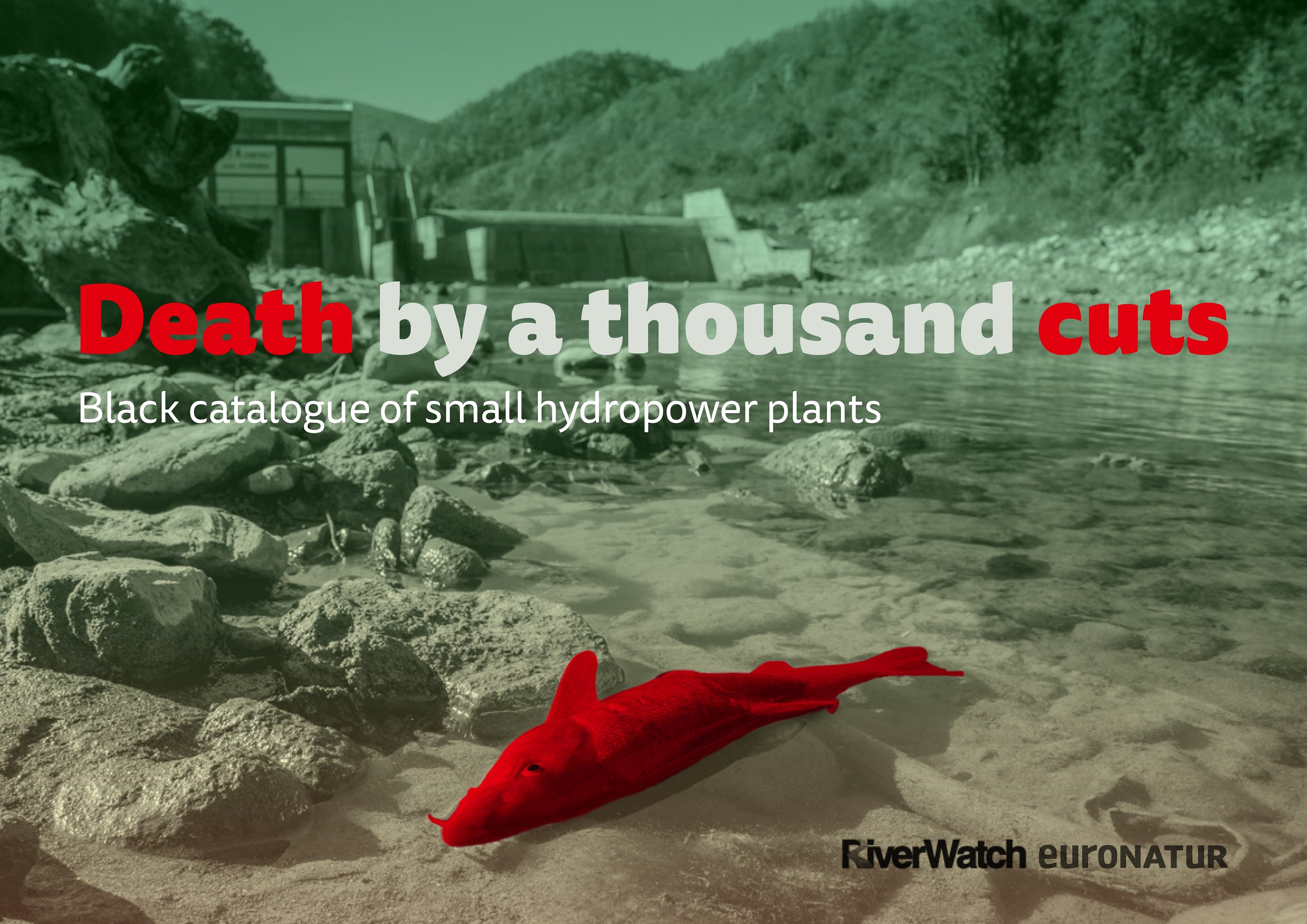 In Europe, 91 percent of the planned 8,000 hydropower plants are “small”, meaning they have an installed capacity of less than 10 megawatt. “Small is beautiful” is what many people think when they hear about small hydropower development. However, the facts show a different picture: migratory fish population in EU have declined by 93% since 1970; on the Balkans 49 fish species are at risk of going extinct, mostly threatened by small dam projects. And people are protesting more than ever against their construction. But what do small dams really look like and how do they affect nature and species around them? Not many people have ever seen a small dam scheme. This is why we prepared this catalogue visualizing the effects of small hydro with drone footage of existing dams.
In Europe, 91 percent of the planned 8,000 hydropower plants are “small”, meaning they have an installed capacity of less than 10 megawatt. “Small is beautiful” is what many people think when they hear about small hydropower development. However, the facts show a different picture: migratory fish population in EU have declined by 93% since 1970; on the Balkans 49 fish species are at risk of going extinct, mostly threatened by small dam projects. And people are protesting more than ever against their construction. But what do small dams really look like and how do they affect nature and species around them? Not many people have ever seen a small dam scheme. This is why we prepared this catalogue visualizing the effects of small hydro with drone footage of existing dams.
Study: Death by a thousand cuts: Black Catalogue of small hydropower plants
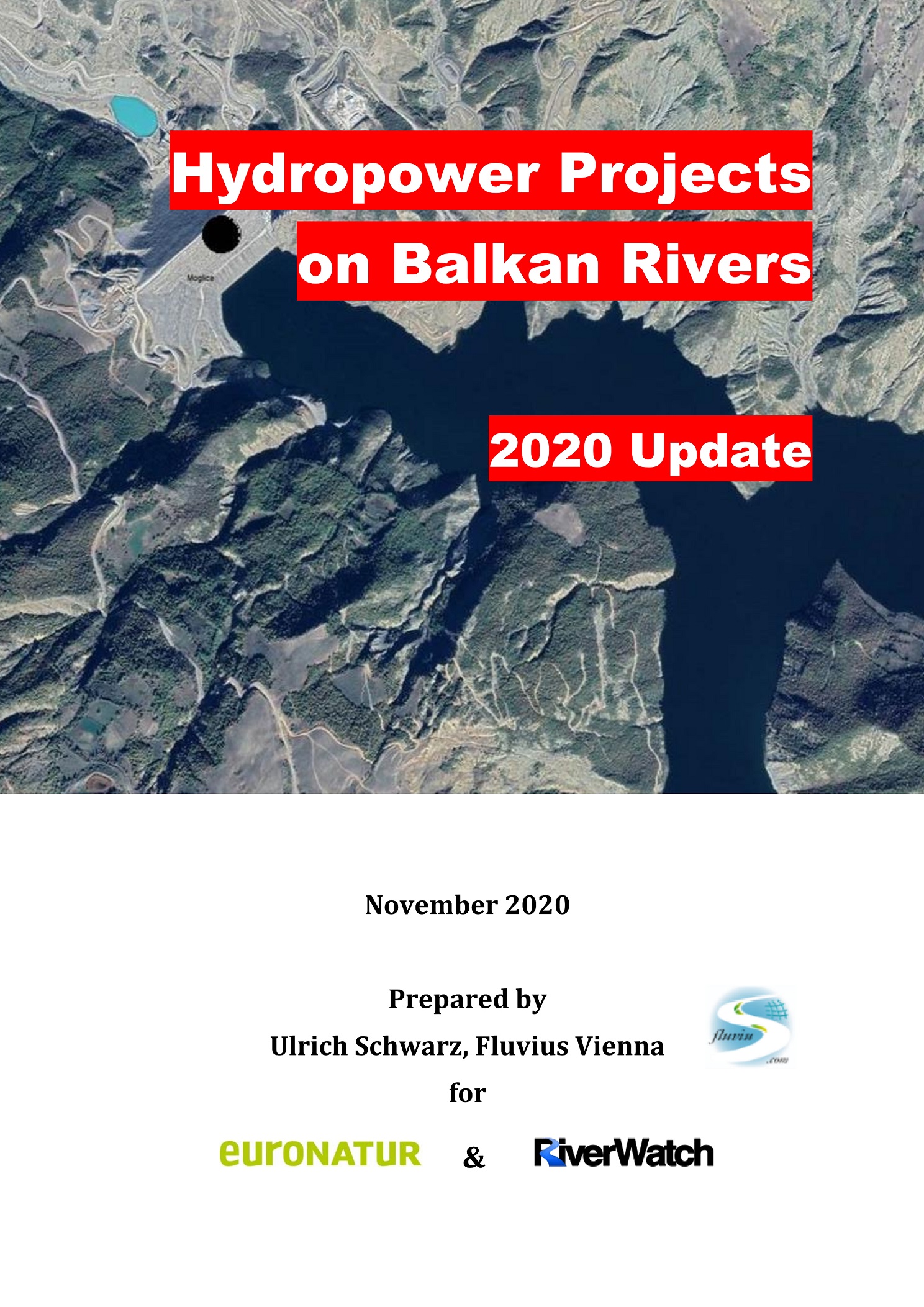 Hydropower projects on Balkan Rivers: 2020 Update
Hydropower projects on Balkan Rivers: 2020 Update
Every two years, we analyse the situation of hydropower development in the Balkans, updating the data of existing and planned hydropower plants as well as those currently under construction. Moreover, we assess how many of these projects are located in protected areas. Since the last update of this kind in 2018, another 300 HPPs came into operation, leaving hundreds of kilometres of rivers and streams devastated. The vast majority (92%) of them are small-scale dams. Currently, 3,431 hydropower plants (HPPs) are planned, 108 under construction and 1,480 are operational in the Balkans. 45% of planned or constructed HPPs are located withing protected areas. The good news: less projects are entering the implementation phase. The number of HPPs under construction is decreasing continuously since its peak in 2017. This is a sustainable trend reversal, which we attribute to our continuous work on the topic.
Study: Hydropower projects on Balkan Rivers: 2020 Update
Threatened Freshwater Fishes of the Mediterranean Basin Biodiversity Hotspot - Distribution, extinction risk and the impact of hydropower
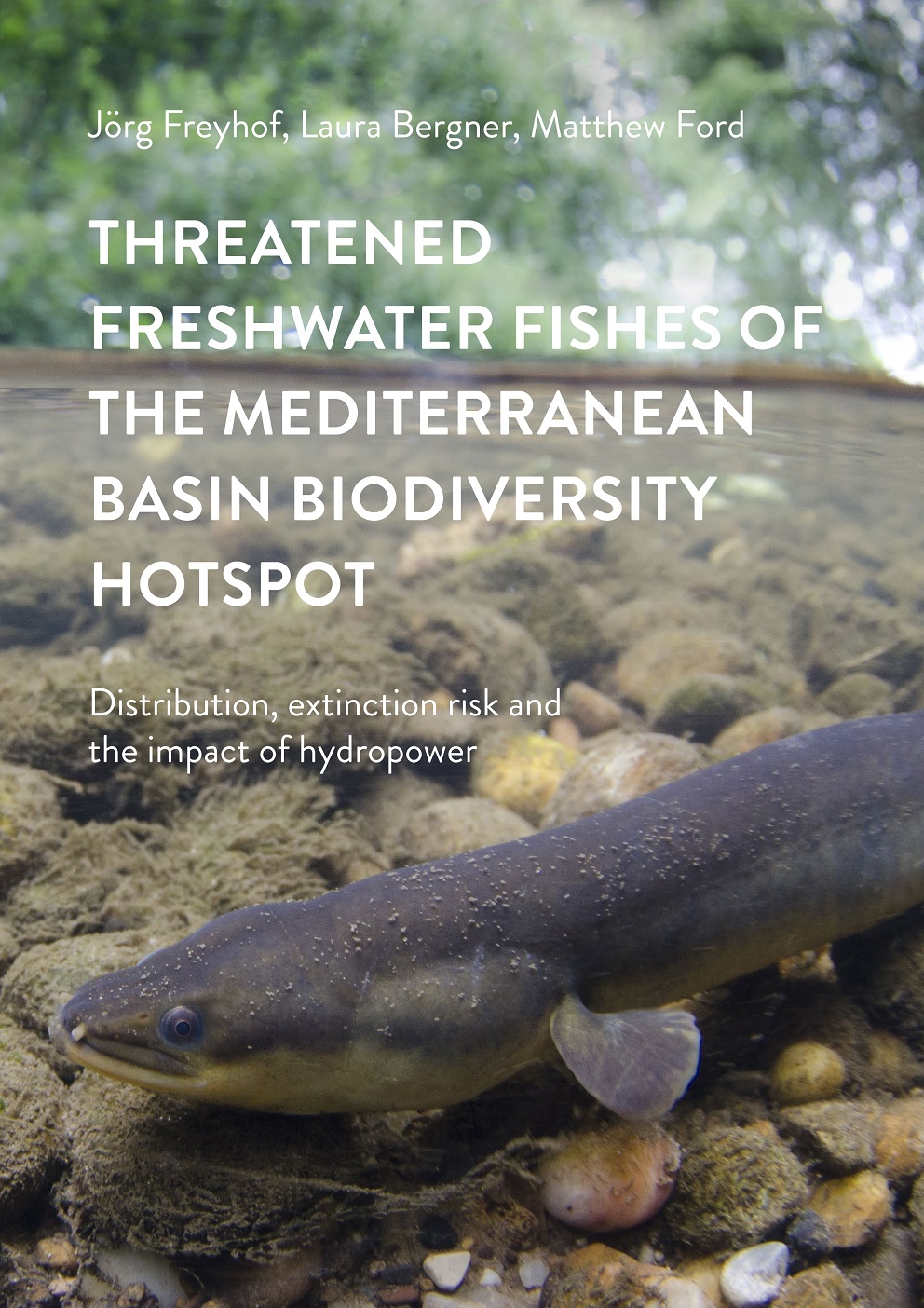 The Mediterranean Basin Biodiversity Hotspot is among the most biologically diverse regions worldwide and renowned for its richness of endemic freshwater species. But the hotspot’s lakes, rivers and wetlands are seriously threatened by an unprecedented boom in hydropower development. Fish expert Dr. Jörg Freyhof and his co-authors examined 251 endangered freshwater fish species along with their stock situation in rivers in the Mediterranean basin were recorded. The impact of existing and planned hydropower plants on these populations was also evaluated. The study reveals that if all the projected plants were to be built, 179 fish species would be driven further towards extinction; another seven species would certainly be put beyond rescue and are likely to become globally extinct. The biggest threat comes from small hydropower plants. 163 fish species alone are threatened with extinction by existing and planned hydropower plants with a capacity of under 10 megawatts.
The Mediterranean Basin Biodiversity Hotspot is among the most biologically diverse regions worldwide and renowned for its richness of endemic freshwater species. But the hotspot’s lakes, rivers and wetlands are seriously threatened by an unprecedented boom in hydropower development. Fish expert Dr. Jörg Freyhof and his co-authors examined 251 endangered freshwater fish species along with their stock situation in rivers in the Mediterranean basin were recorded. The impact of existing and planned hydropower plants on these populations was also evaluated. The study reveals that if all the projected plants were to be built, 179 fish species would be driven further towards extinction; another seven species would certainly be put beyond rescue and are likely to become globally extinct. The biggest threat comes from small hydropower plants. 163 fish species alone are threatened with extinction by existing and planned hydropower plants with a capacity of under 10 megawatts.
The study was commissioned by nature conservation organisations EuroNatur and Riverwatch, together with Wetlands International Europe, GEOTA and WWF Adria.
Study: Threatened Freshwater Fishes of the Mediterranean Basin Biodiversity Hotspot
Press release: Fishes in Mediterranean region endangered due to hydropower boom
Contribution to biodiversity knowledge of the Aoos river basin
The present biodiversity study has been conducted on the Greek part of the Aoos-Vjosa river. It focuses on insect species related to water (Odonata), as well as on large mammals, either directly related to the riverine ecosystems (otter) or indirectly (carnivores and ungulates). The study’s results underline the great biological importance of the non-protected part of Aoos basin for the conservation of the studies' key-species. The scientific evidence provided by the study highlight the crucial need to expand the protected area in Greece towards the Greek-Albanian borders, the need for the protection of the river from future hydropower constructions and, even more, the need to establish a Transboundary Wild River National Park – Vjosa/Aoos. Commissioned by Pindos Perivallontiki
Study: Contribution to biodiversity knowledge of the Aoos river basin
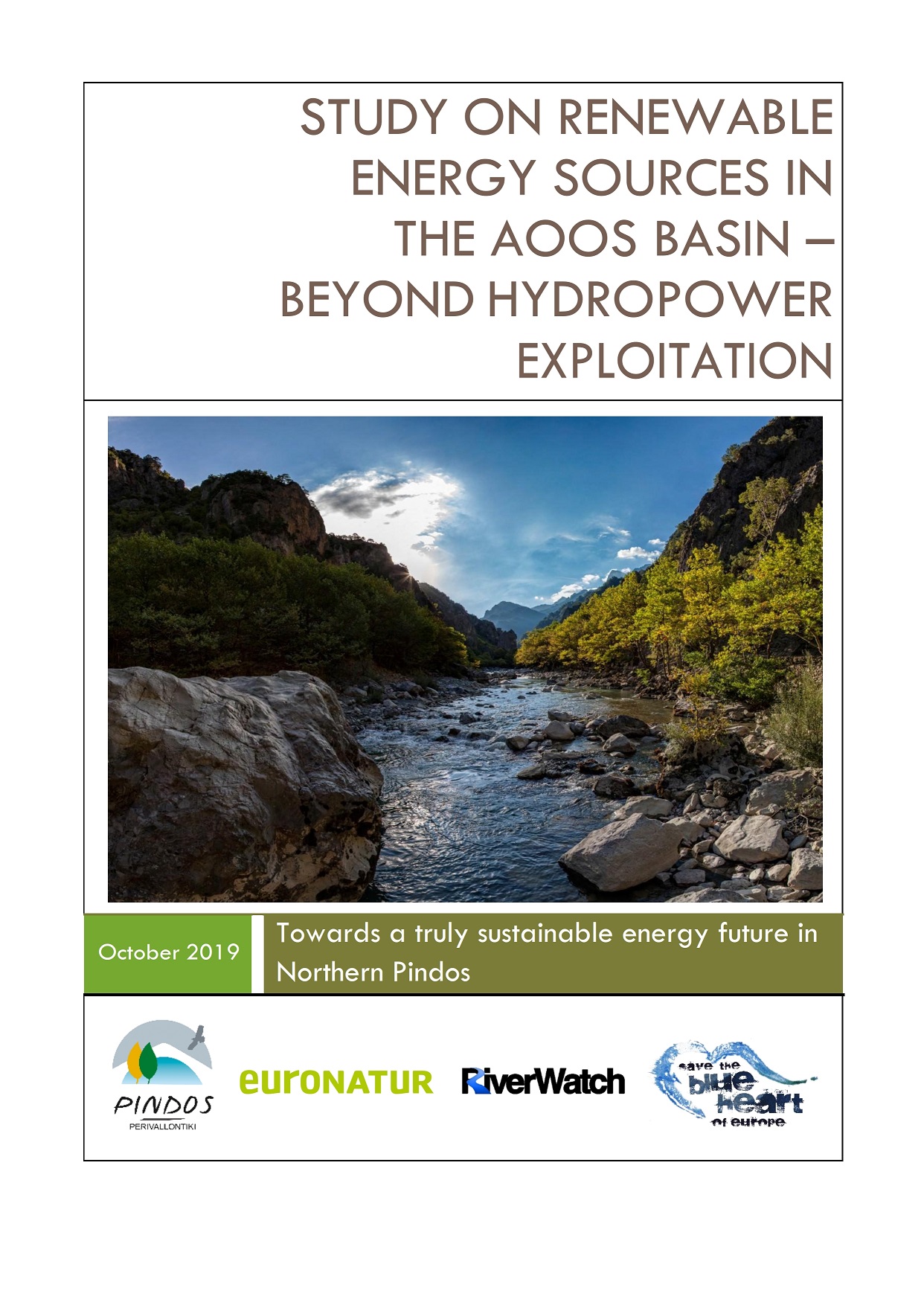 Renewable energy sources in the Aoos basin
Renewable energy sources in the Aoos basin
This study shows that further development of hydropower in Greece, and particularly in the Aoos river basin, is a strategy that has detrimental environmental impacts. Moreover, expansion of hydropower is not necessary for reaching the RES (Renewable Energy Sources) development goals of the country. This study, commissioned by Pindos Perivallontiki, includes:
- An overview of Greek energy policy.
- An assessment of the role of hydropower in Greek energy policy and its implications for Aoos basin.
- A presentation of alternative RES development scenarios that do not prioritize hydropower in energy planning and outlook for (alternative/non-HP) developments in Aoos basin.
Study: Renewable energy sources in the Aoos basin
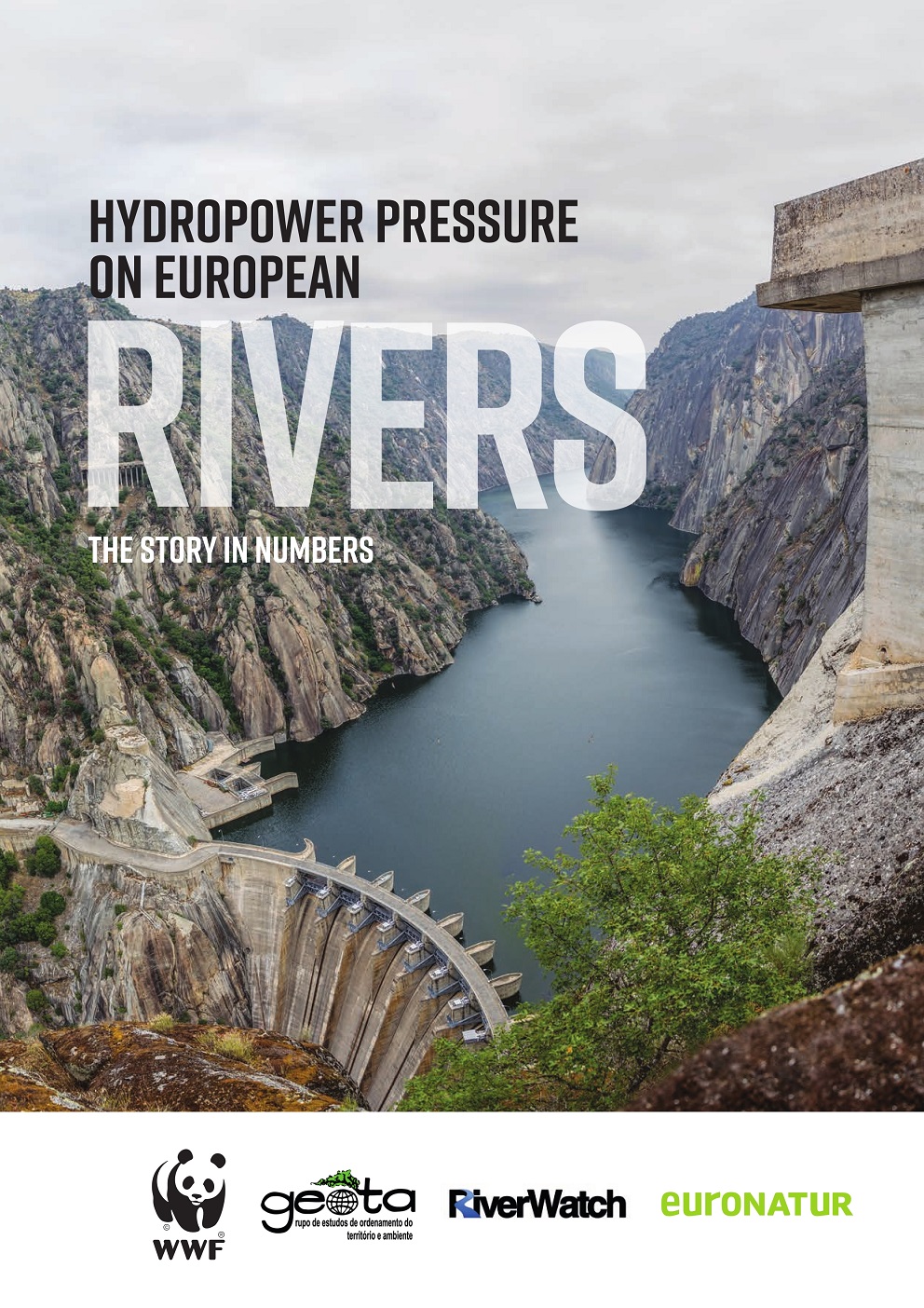 Hydropower Pressure on European Rivers: The Story in Numbers
Hydropower Pressure on European Rivers: The Story in Numbers
The first pan-European inventory of existing and planned hydropower plants shows the immense pressure on rivers throughout the continent, despite EU rules which should limit new hydropower plants. In addition to the 21,387 existing hydropower plants, another 8,785 are planned, mainly in the Alps and the Balkans. Previously untouched rivers – especially in the Balkans – are to be destroyed. 28% of planned hydropower projects are situated in protected areas, mainly in national parks and Natura 2000 sites. The study also evidences an alarming rise in small hydropower (91%), which wreaks environmental havoc whilst producing very little energy.
The study was commissioned by EuroNatur, Riverwatch, WWF, and GEOTA. Its findings highlight the failure of governments both within and outside the EU to protect rivers and biodiversity, and document plain disregard of EU water protection legislation, in particular the Water Framework Directive.
Hydropower Pressure on European Rivers: The Story in Numbers – Full Report
Hydropower Pressure on European Rivers: The Story in Numbers – Summary Report
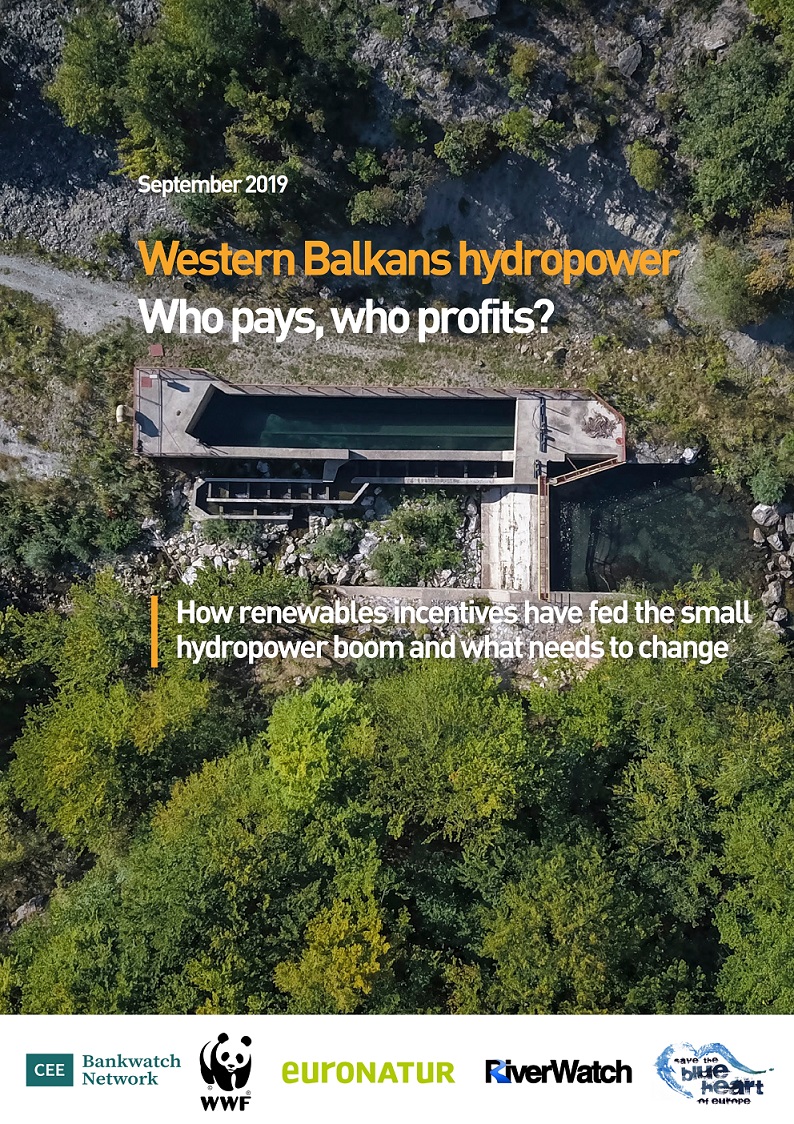 Hydropower Subsidy Study - Western Balkans hydropower: Who pays, who profits?
Hydropower Subsidy Study - Western Balkans hydropower: Who pays, who profits?
Disproportionate public subsidies for small hydropower in the Western Balkans have resulted in widespread environmental damage and have benefited wealthy business people close to or part of the region’s governments, with little benefit for electricity generation, finds this study by CEE Bankwatch Network.
Fuelled by generous state-sponsored feed-in tariffs that contradict EU guidelines on state aid for environmental protection and energy, the number of hydropower plants under 10 megawatts in Albania, Bosnia and Herzegovina, Kosovo, Montenegro, North Macedonia and Serbia quadrupled from 108 to at least 488 between 2009 and 2018. Whilst the speed of development on solar and wind power projects has been glacial, in 2018 no less than 70 per cent of renewable energy incentives awarded in the region benefited small hydropower. Despite this support, small hydropower only generated 3.6 per cent of total electricity.
Study: Western Balkans hydropower: Who pays, who profits?
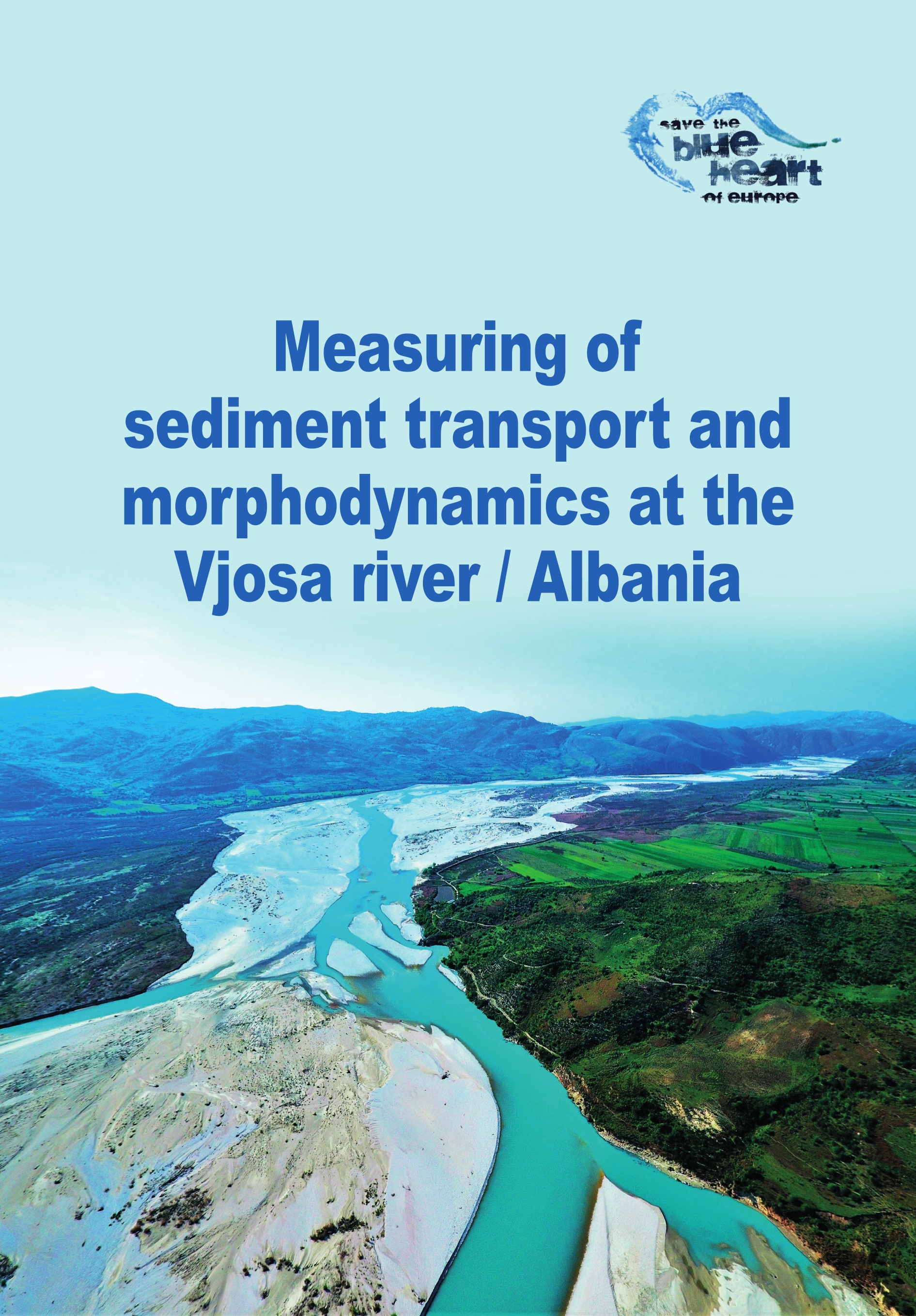 Vjosa Sediment Study: Hardly any energy, no sand for the beach
Vjosa Sediment Study: Hardly any energy, no sand for the beach
For over a year, scientists from the University of Natural Resources and Applied Life Sciences Vienna (BOKU) have been studying the sediment transport of the Vjosa river for different high and low water phases. They measured how much gravel, sand and fine sediment the Vjosa is transporting and calculated the annual sediment loads of the river. From these results, the researchers were able to predict the consequences on energy production, ecosystems and the Adriatic coast, if the sediments would be held back behind the planned Kalivac and Pocem dam walls. The scientists’ conclusions: the projected hydropower plans on the Vjosa would lead to a lose-lose-lose situation:
- High economic costs due to the enormous sediment deposition in the reservoirs and the decreasing energy production,
- Ecological degradation of a unique river system,
- Long-term negative consequences for the beaches and thus for the tourism of the region.
Study: Measuring of sediment transport and morphodynamics at the Vjosa river/Albania
Infographic Annual Sedimentation / Infographic Loss of Energy Potential / Infographic River Bed Incision / Infographic Coastal Erosion
Press release: New Vjosa study: hardly any energy, no sand for the beach
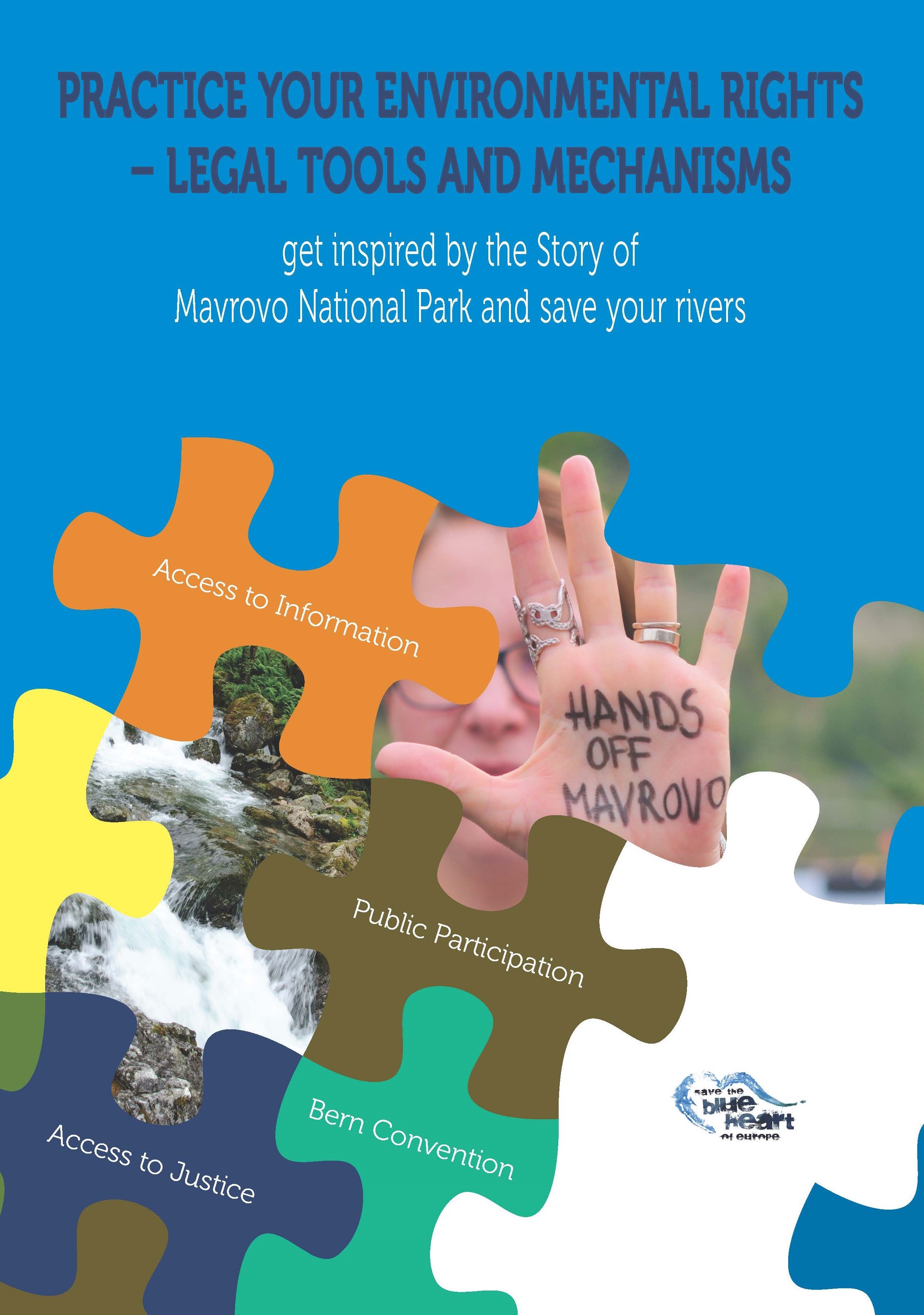 Practice your environmental rights – legal tools and mechanisms
Practice your environmental rights – legal tools and mechanisms
The legal toolkit provides guidance for national and international CSOs and activists on how to use their environmental rights with a special focus on the protection of rivers from destructive hydropower developments. It explains how to practice existing environmental rights in the decision-making processes on national and international level. It hereby refers to the Aarhus Convention, the Bern Convention and the environmental and social policies of international financial institutions which provide financial assistance for hydropower projects. The toolkit also contains a collection of case studies derived from the direct experiences in the protection of the Mavrovo National Park as well as a selection of events and actions that can be used as supplements to legal procedures in order to gather support, keep the public informed and put pressure on decision makers.
Legal Toolkit: Practice your environmental rights – legal tools and mechanisms (ENGLISH)
Legal Toolkit: Practice your environmental rights – legal tools and mechanisms (MACEDONIAN)
Eco-Masterplan for Balkan Rivers
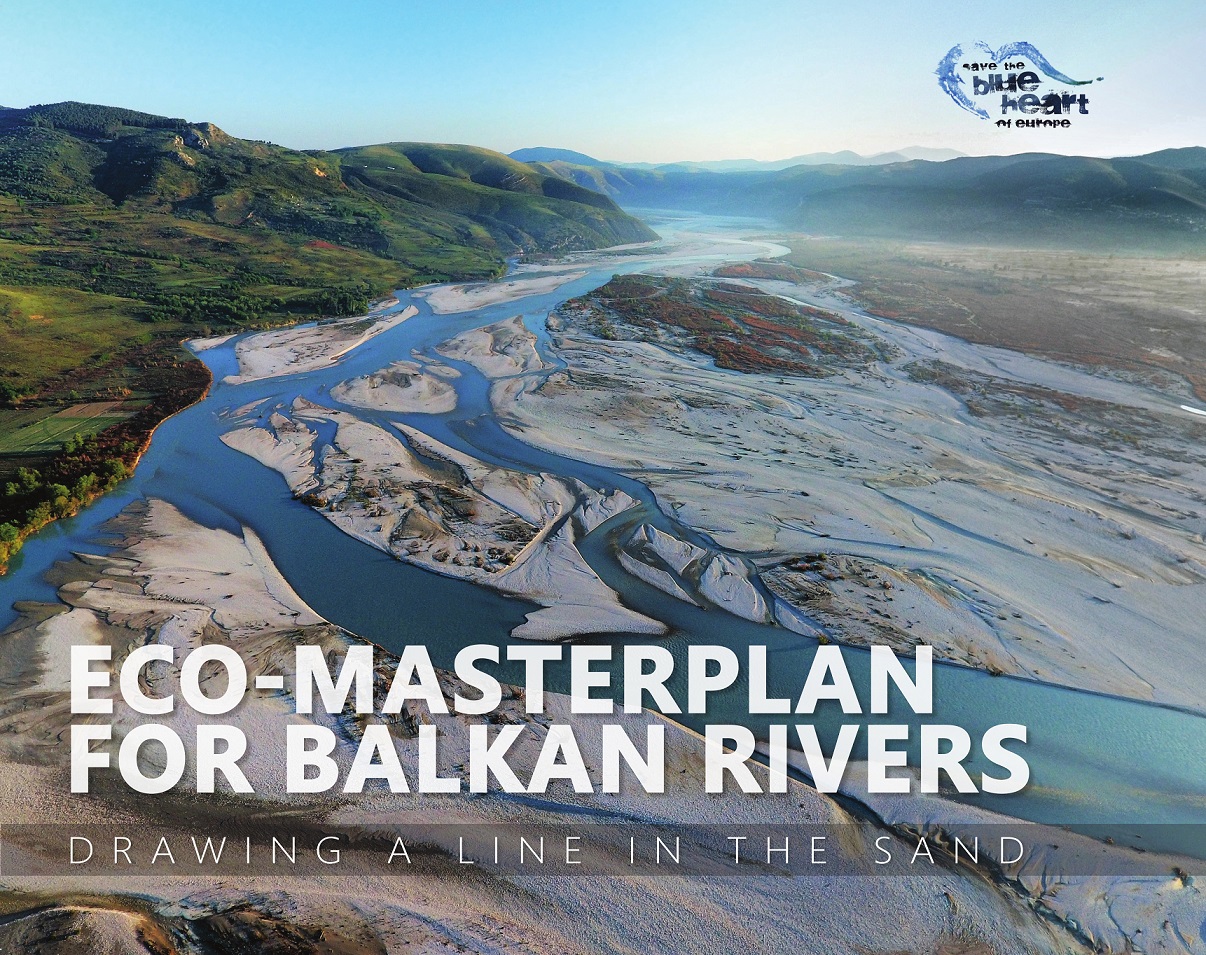 The Eco-Masterplan for Balkan Rivers is a comprehensive study which, for the first time, combines knowledge about biodiversity (fish, mussels, caddisflies), integrity of rivers and floodplains (hydromorphology), as well as the location of protected areas. A river network of over 80,000 kilometers in length was scientifically assessed according to these criteria. The result: about 61,000 kilometers of river (76 percent) are of high ecological quality and therefore designated as No-go zones for hydropower expansion. An energy study included in the Eco-Masterplan shows that the hydropower projects currently foreseen in the Balkans could be easily substituted by the other sources of renewable energy, particularly solar and wind.
The Eco-Masterplan for Balkan Rivers is a comprehensive study which, for the first time, combines knowledge about biodiversity (fish, mussels, caddisflies), integrity of rivers and floodplains (hydromorphology), as well as the location of protected areas. A river network of over 80,000 kilometers in length was scientifically assessed according to these criteria. The result: about 61,000 kilometers of river (76 percent) are of high ecological quality and therefore designated as No-go zones for hydropower expansion. An energy study included in the Eco-Masterplan shows that the hydropower projects currently foreseen in the Balkans could be easily substituted by the other sources of renewable energy, particularly solar and wind.
All this data is shown in graphs and maps. The Eco-Masterplan is a suitable tool to curb the devastating plans for hydropower expansion in the Balkans, to preserve biodiversity and beauty of these river landscapes, to avoid social conflicts and to increase planning security for investors.
Visual Story-Map about the Eco-Masterplan
Study: Eco-Masterplan for Balkan Rivers (original format)
Study: Eco-Masterplan for Balkan Rivers (A4 format)
Press release: Eco-Masterplan shows value of Balkan Rivers
Alternatives to hydropower in the Balkans
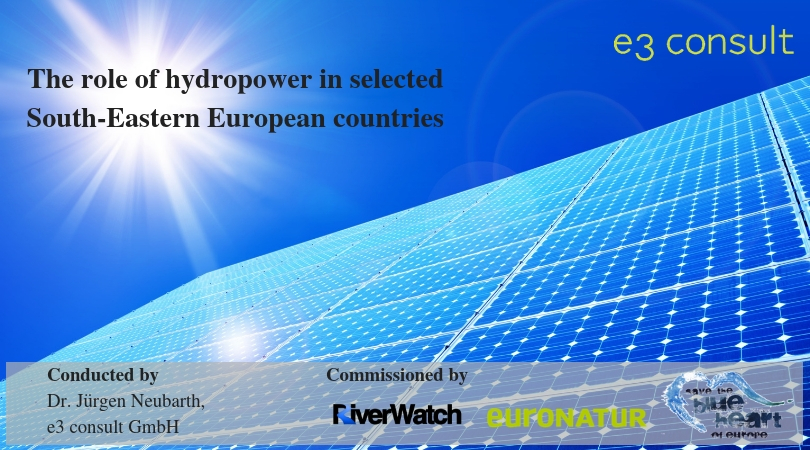 The countries in the Balkans are facing a dilemma: they must fulfill the EU renewable targets while also follow environmental legislation. This raises the question: Is it possible to increase the renewable energy share AND keep the Balkan Rivers alive? We commissioned the energy expert Dr. Jürgen Neubarth with this question and his study “The role of hydropower in selected South-East European countries” shows that it is possible. The potential of environmentally much sounder sources of energy, such as wind and solar, is up to twice as high as the current electricity demand in the sun-kissed Balkan countries and exceeds the potential from hydropower by about five times! Thus, there is actually no need for new hydropower development. Moreover, most Balkan countries would still fail to reach their renewable targets even if all economically feasible hydropower plants were built, including in protected areas like national parks. Thus, a complete switch in the energy policy is needed. The data sows that this is possible.
The countries in the Balkans are facing a dilemma: they must fulfill the EU renewable targets while also follow environmental legislation. This raises the question: Is it possible to increase the renewable energy share AND keep the Balkan Rivers alive? We commissioned the energy expert Dr. Jürgen Neubarth with this question and his study “The role of hydropower in selected South-East European countries” shows that it is possible. The potential of environmentally much sounder sources of energy, such as wind and solar, is up to twice as high as the current electricity demand in the sun-kissed Balkan countries and exceeds the potential from hydropower by about five times! Thus, there is actually no need for new hydropower development. Moreover, most Balkan countries would still fail to reach their renewable targets even if all economically feasible hydropower plants were built, including in protected areas like national parks. Thus, a complete switch in the energy policy is needed. The data sows that this is possible.
Study: The role of hydropower in selected South-East European countries
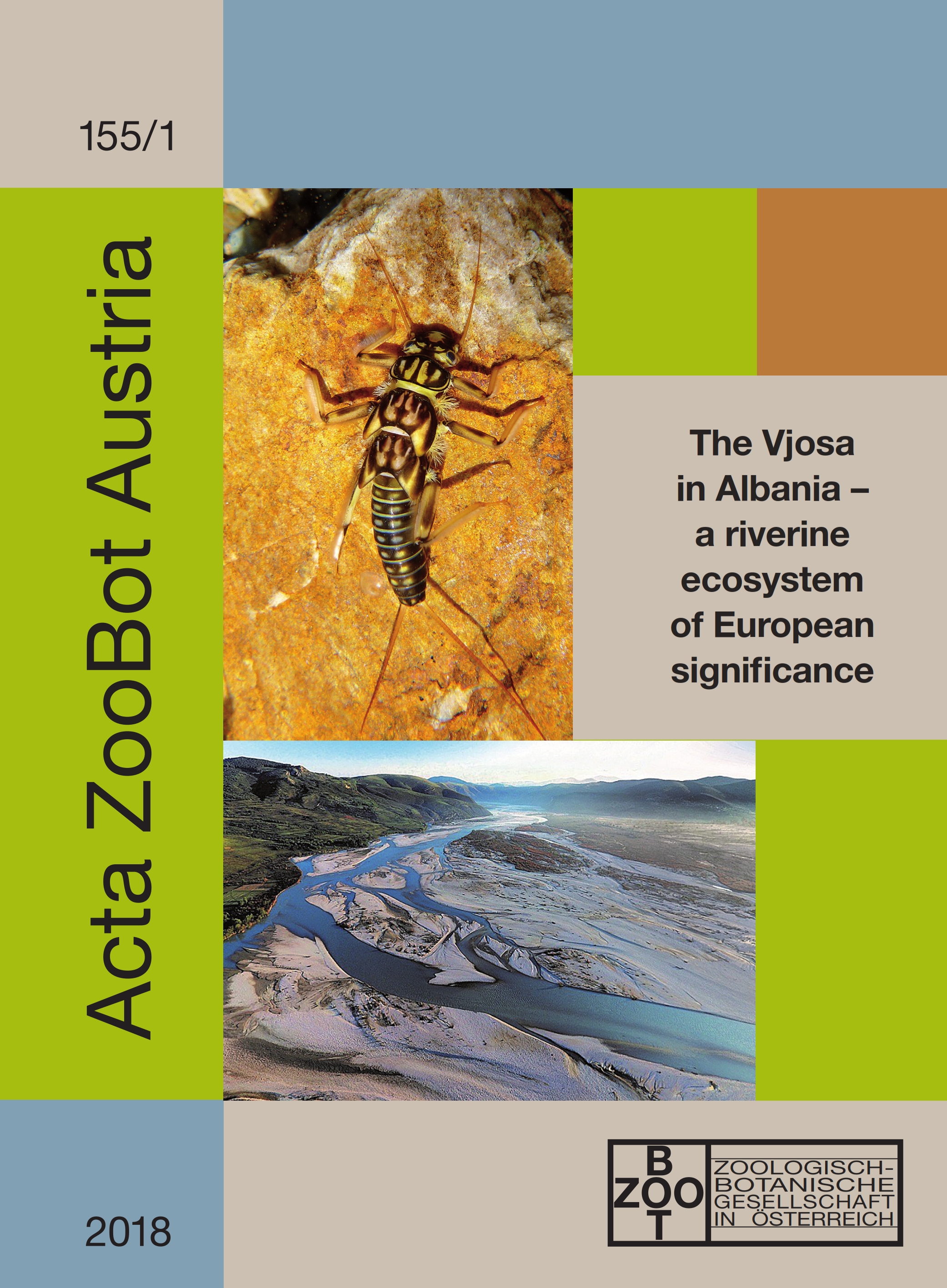 The Vjosa in Albania - a riverine ecosystem of European significance
The Vjosa in Albania - a riverine ecosystem of European significance
More than 60 scientists from Albania, Austria and Germany have collected their knowledge about the biodiversity and ecology of the Vjosa and published it on 385 pages in this volume. Vjosa in Albania is the last large wild river in Europe outside Russia, free-flowing on a course of over 260 km without significant technical obstacles. As such, the Vjosa can serve as an invaluable reference system for future renaturation projects. In the rest of Europe such natural conditions have long gone and knowledge of how natural rivers look like and function is lost. Surprisingly, the Vjosa and their tributaries are still largely unexplored. The scientists from the three countries have joined forces to change that, to provide argumentation for the preservation of the Vjosa and against the plans of the Albanian government to build Vjosa hydroelectric power plants.
Published in Acta ZooBot Austria
Publication: The Vjosa in Albania - a riverine ecosystem of European significance
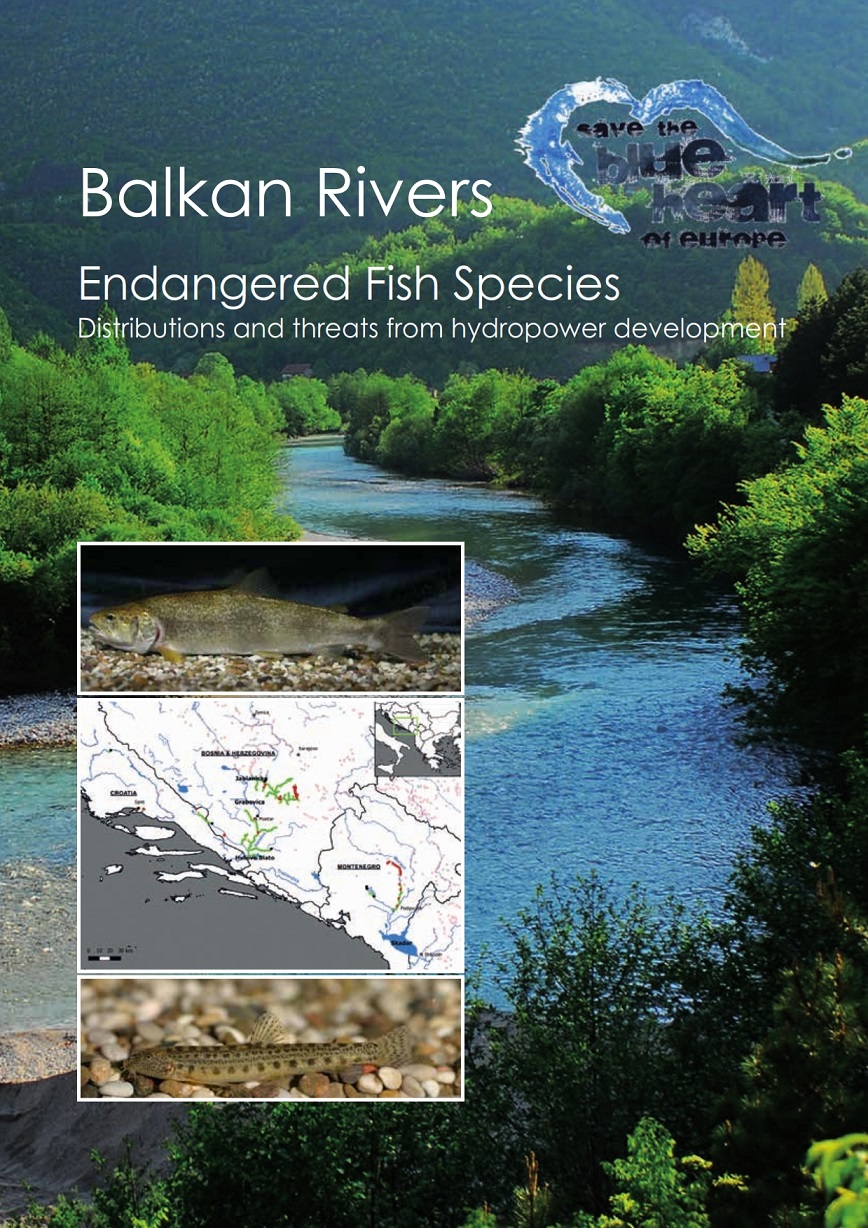 Balkan Rivers – Endangered Fish Species: Distribution and threats from hydropower development
Balkan Rivers – Endangered Fish Species: Distribution and threats from hydropower development
This study proves that the rivers in the Balkans constitute Europe’s fish sanctuary: 113 endangered fish species find habitat in the rivers between Slovenia and Greece – more than in any other region in Europe. Fish expert Dr. Steven Weiss from the University of Gras and his co-authors also assessed the consequences for the fish fauna, if the projected hydropower plants in the Balkans were to be constructed. The result is alarming: up to 49 freshwater fish species are faced with either the threat of extinction or loss of between 50 and 100% of their Balkan distribution. Of these, eleven endemic species are threatened with extinction, seven will become critically endangered, and the number of endangered species will double to twenty-four. For 68 of 69 endemic species, habitat losses are estimated between 30 and 100%, resulting in increased levels of endangerment for essentially the entire endemic fauna. Additionally, the four migratory sturgeon species would essentially lose their potential for rehabilitation in the lower Danube if additional dams were constructed there.
Balkan Rivers – Endangered Fish Species: Distribution and threats from hydropower development – Full Study
Online Fish Database
Interactive Distribution Map
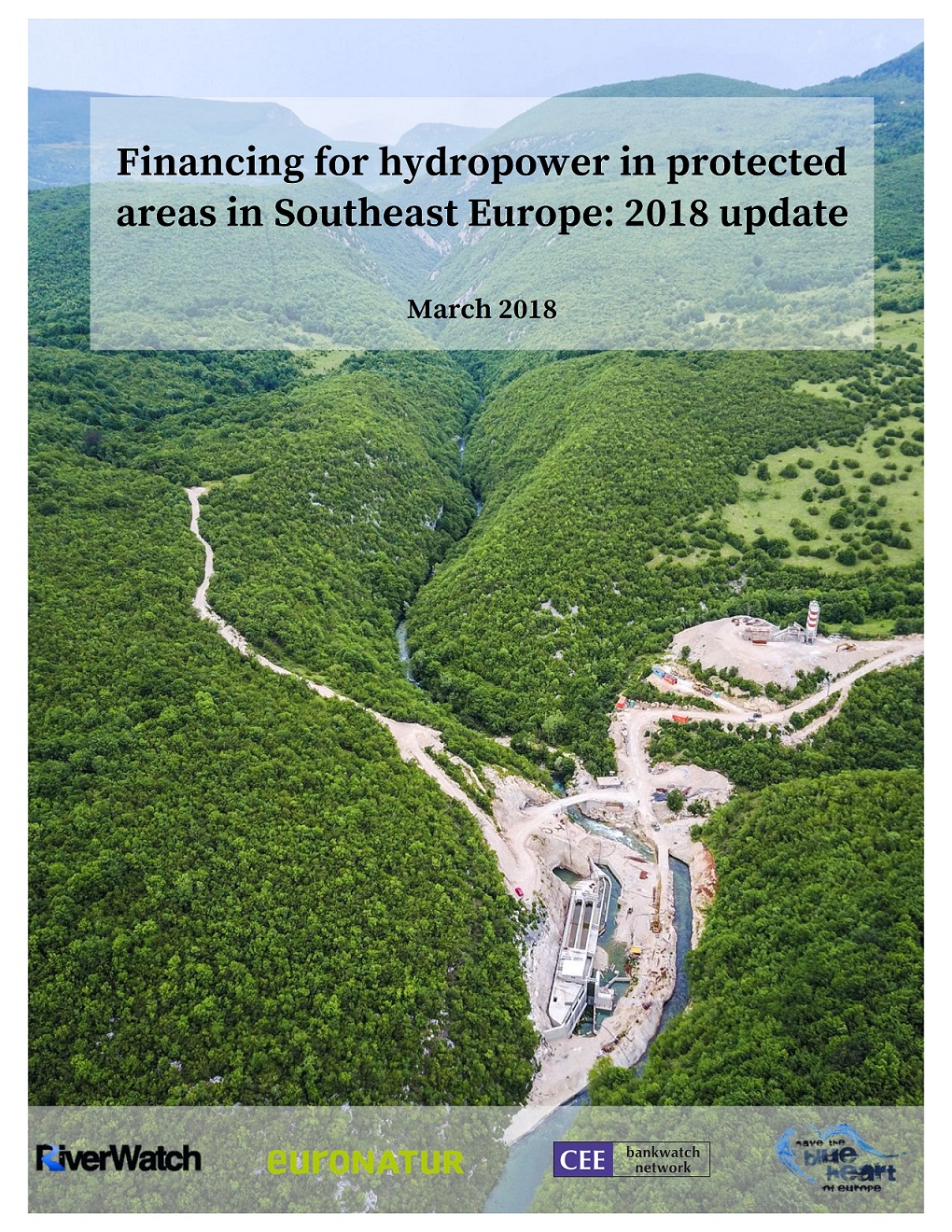 Financing for hydropower in protected areas in Southeast Europe: 2018 update
Financing for hydropower in protected areas in Southeast Europe: 2018 update
As the 2015 Bankwatch study “Financing for hydropower in protected areas in Southeast Europe” (see further down) shows, international commercial and public banks have been bankrolling a wave of hydropower projects across southeast Europe that have damaged pristine rivers, including in protected areas. This 2018 update finds that the number of financed hydropower projects in the region is even greater than previously known. These include the European Bank for Reconstruction and Development (EBRD), the EU’s house bank the European Investment Bank (EIB), the World Bank Group and commercial banks such as Austria’s Erste Bank and Italy’s Unicredit Group.
Financing for hydropower in protected areas in Southeast Europe: 2018 update - Full Study
Financing for hydropower in protected areas in Southeast Europe: 2018 update - Database
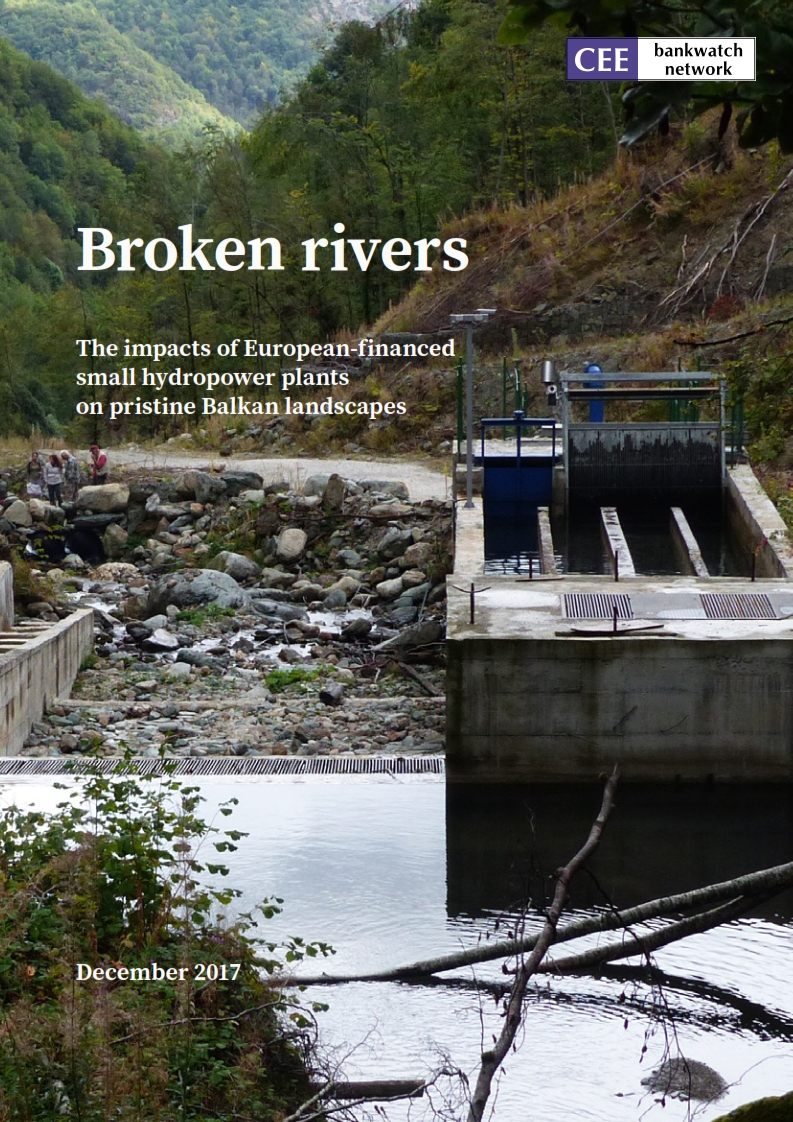 Rivers – The impact of European-financed small hydropower plants on pristine Balkan landscapes
Rivers – The impact of European-financed small hydropower plants on pristine Balkan landscapes
Within the context of the Blue Heart of Europe campaign, the NGO Bankwatch visited eight recently constructed small hydropower plants in Albania, Macedonia and Croatia. All of them were financed by the European Bank for Reconstruction and Development (EBRD) and the European Investment Bank (EIB). In a nutshell, the projects have damaged biodiversity and are in urgent need of increased monitoring and restoration measures. All findings are published in this Bankwatch report. If you always wanted to know whether 'small' is actually 'beautiful' when it comes to hydropower, find out the truth in this study.
 Hydropower development in the Balkans: data update 2017
Hydropower development in the Balkans: data update 2017
Every two years, we analyze the situation of hydropower development in the Balkans, updating the data of existing and planned hydropower plants as well as those currently under construction. Moreover, we assess how many of these projects are located in protected areas. This 2017 data update makes the extent of the threat to the Blue Heart of Europe visible: Currently, 2,796 hydropower plants are in the planning phase, 188 are under construction, while another 1,004 plants are already operating. 1,031 (or 37%) of the planned dams are projected to be built in protected areas with high protection status (118 of which in national parks, 547 in Natura 2000 areas). What this means in comparison to the 2015 data set you can read in the summary below
2017 Data Set Summary
Collection of graphs
Graphs by country:
| Albania | Bosnia & Herzegovina | Macedonia | Serbia |
| Kosovo | Bulgaria | Slovenia | Croatia |
| Montenegro | Greece | Turkey |
Sava White Book – The River Sava: Threats and Restoration Potential
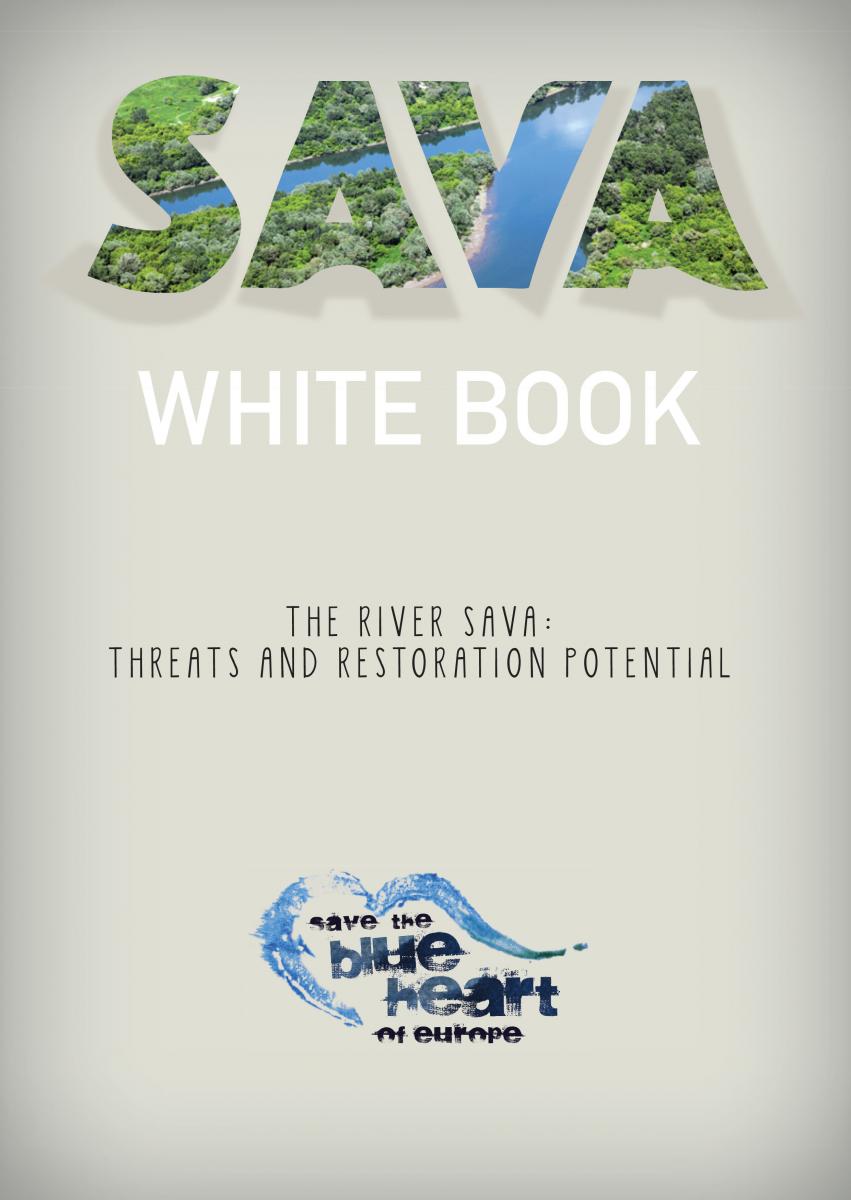 The Sava is one of the most interesting and complex rivers in Europe. Along its course of 926 kilometres, the Sava features the entire spectrum of different rivers habitats. Together with tributaries, the Sava basin constitutes one of the best preserved and most diverse river systems in Europe. Unfortunately, like so many other European rivers, the Sava stands at a crossroad: on the one hand improving the ecological condition of water bodies is a clearly defined goal of the European Union. On the other hand, flood protection, recreational use and transport capacities, etc. are to be increased as well. Moreover, hydropower developments, sediment exploitation and navigation upgrades put further strain on the river.
The Sava is one of the most interesting and complex rivers in Europe. Along its course of 926 kilometres, the Sava features the entire spectrum of different rivers habitats. Together with tributaries, the Sava basin constitutes one of the best preserved and most diverse river systems in Europe. Unfortunately, like so many other European rivers, the Sava stands at a crossroad: on the one hand improving the ecological condition of water bodies is a clearly defined goal of the European Union. On the other hand, flood protection, recreational use and transport capacities, etc. are to be increased as well. Moreover, hydropower developments, sediment exploitation and navigation upgrades put further strain on the river.
In which direction is the Sava going? This is the very question we asked ourselves within the context of the “Save the Blue Heart of Europe” campaign. Our answer is this White Book. It shall serve as an extensive and comprehensive overview of the situation of the Sava. However, what makes this White Book truly unique is that it is the first study offering suggestions for area-specific ecological flood control and river restoration projects. In other words, we show where former alluvial areas could be naturally flooded once again and in which sections the Sava’s river bed should be given more space.
Sava White Book – Full Study
Sava White Book – Map Annex
Sava White Book – Croatian Executive Summery
Financing for hydropower in protected areas in Southeast Europe
Southeast Europe is experiencing a wave of hydropower projects. In a region with a deadly combination of Europe's last wild rivers, rampant corruption and inadequate nature protection, the potential for damage is immense. A recent study by Dr Ulrich Schwarz (see study "Hydropower Projects in Protected Areas on the Balkans" below) found that almost half of the planned projects are in protected areas. This research aims - to the extent possible given the secrecy around the financial sector - who are the main actors involved in financing hydropower projects in the region, both overall and inside of protected areas. The extensive analysis shows that multilateral development banks are playing a key role. The European Bank for Reconstruction and Development (EBRD), the European Investment Bank (EIB), and the World Bank's International Finance Corporation (IFC) have extended loans totalling EUR 818 million to no less than 75 hydropower projects, including 30 directly affecting protected areas like national parks, Natura 2000 sites, and Ramsar sites.
!!! Update January 2017 !!!
The EBRD has said that financing has been cancelled for four small hydropower plants in Macedonia: Zrnovska reka 1, Zrnovska reka 2, Estericka reka, Kadina reka. In addition, financing has been cancelled for the 68 MW Boskov Most plant in the Mavrovo National Park, also in Macedonia. Regarding the Ternove SHPP in Albania, the EBRD has said that it had conducted an on-site investigation into the concerns received in a letter from an affected citizen. The bank found nothing to substantiate the allegations. Bankwatch will continue to monitor the issue.
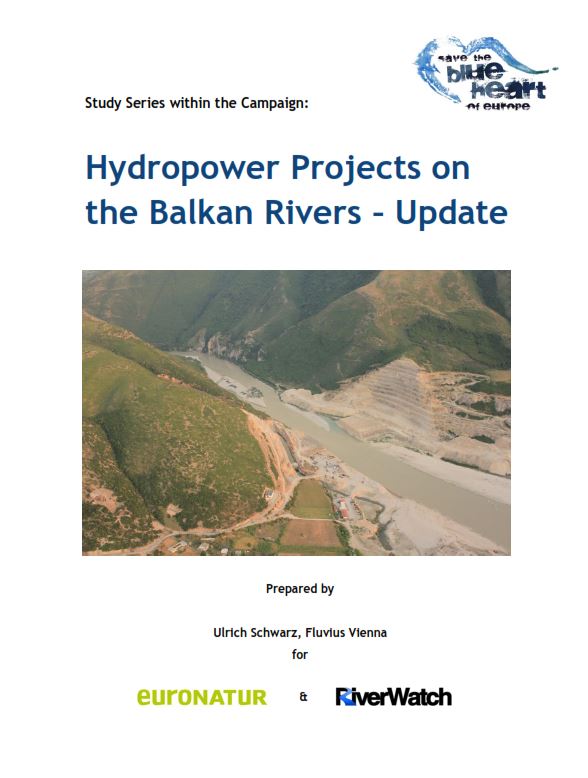 Hydropower Projects on the Balkan Rivers – Update
Hydropower Projects on the Balkan Rivers – Update
In a follow-up study of the initial "Hydromorphological Status and Dam Projects" study from 2012 (U. Schwarz), we included small hydropower plants as well, when previously only those over 1 MW were recorded. A total of 2,683 future hydropower projects have been recorded on the Balkan Peninsula. Additionally, 714 existing dams were found in this region. Based on four size categories the 2,683 planned HPPs are distributed as follows: 68 very large projects (> 50 MW), 178 large projects (10-50 MW), 867 medium projects (1-<10 MW) and 1,570 small projects (0.1-< 1 MW) were identified.
Hydropower Projects on the Balkan Rivers – Update - Full Study
Maps:
| entire region | Slovenia | Croatia | Bosnia & Herzegovina |
| Serbia | Montenegro | Kosovo | Albania |
| Macedonia | Bulgaria | Greece | Turkey |
Hydropower Projects in Protected Areas on the Balkans
This study aims to quantify the number of hydropower projects that are planned within protected areas on the Balkan Peninsula. A total of 1,640 projected hydropower plants (HPPs) have been examined based on a detailed and categorized network of protected areas. A total of 535 planned projects or 32 % fall in strictly protected areas. In addition, 282 HPPs (17 %) are projected inside other protected areas with a weaker protection status. Altogether, 817 or 49% of all projected HPPs fall in protected areas, which points to the fact that this practice is the rule rather than an exception. This indicates a very high pressure of hydropower on protected sites.
Hydropower Projects in Protected Areas on the Balkans - Full Study
Hydropower Projects in Protected Areas on the Balkans - English Summary
Hydropower Projects in Protected Areas on the Balkans - German Summary
Hydropower Projects in Protected Areas on the Balkans - Slovenian Summary
Hydropower Projects in Protected Areas on the Balkans - Croatian Summary
Hydropower Projects in Protected Areas on the Balkans - Albanian Summary
Hydropower Projects in Protected Areas on the Balkans - Macedonian Summary
Maps:
Hydropower Projects in all Protected Areas - MAP
Hydropower Projects in National Parks - MAP
Hydropower Projects in Ramsar/Biosphere Reserves/UNESCOWorld Heritage Nature Sites - MAP
Hydropower Projects in Natura2000 Sites - MAP
Hydropower Projects in Nature Reserves and EMERALD Sites - MAP
Hydropower Projects in other protected areas - MAP
The Huchen Hucho hucho in the Balkan region
Distribution and future impacts by hydropower development
The Huchen or Danube Salmon is one of the most enigmatic species of Europe's freshwater fauna. It is a sensitive indicator species for some of the most ecologically valuable rivers in the Danube drainage. Historically, the species was wide-spread across the entire Danube basin. Since the late 19th century, however, Huchen populations declined by two thirds and the remaining populations are now highly endangered by hydropower development. But knowledge on the distribution of the Huchen on the Balkan Peninsula has been incomplete.
Within the context of the international campaign “Save the Blue Heart of Europe”, 18 scientists from 7 countries explored for the first time, in which rivers between Slovenia and Montenegro the Huchen can still be found. The results clearly show that the Balkan rivers constitute the last big hot spot for this species. Self-sustaining populations of Huchen were found in 43 rivers with a total length of 1,842 kilometres. This corresponds to 65 percent of all known Huchen stretches worldwide. However, 93 hydropower plants are projected directly in stretches with healthy Huchen populations. Experts predict a population decline of up to 70%, if these dams become reality.
The Huchen Hucho hucho in the Balkan region - Full Study
The Huchen Hucho hucho in der Balkan region - English Summary
The Huchen Hucho hucho in the Balkan region - German Summary
The Huchen Hucho hucho in the Balkan region - Slovenian Summary
The Huchen Hucho hucho in the Balkan region - Croatian Summary
The Huchen Hucho hucho in der Balkan region - Maps jpg map 1 jpg map 2
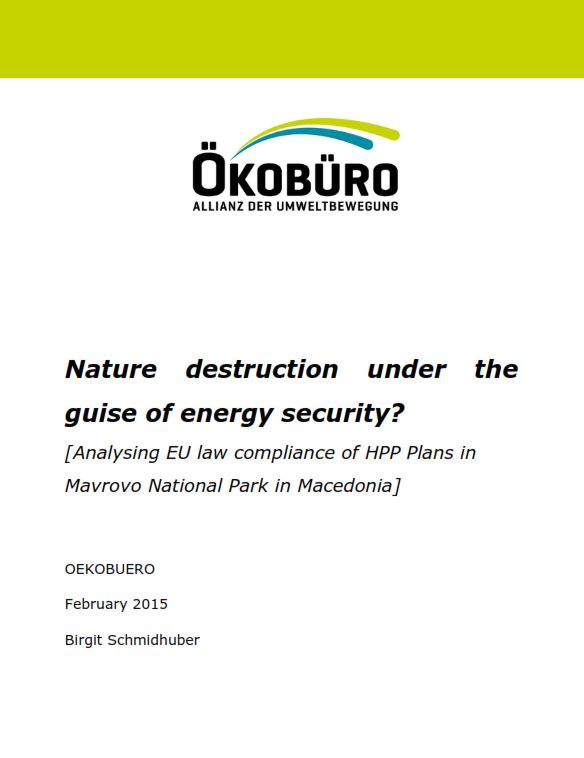 Compliance of HPP Plans in Mavrovo National Park in Macedonia with EU legislation
Compliance of HPP Plans in Mavrovo National Park in Macedonia with EU legislation
The compliance with EU legislation and guidelines of all hydropower projects inside the Mavrovo National Park in Macedonia was analyzed by the Ökobüro - an environmental alliance based in Austria. Legal experts conclude that the projects strongly violate EU law. Particularly alarming is the lack of environmental data leading to false and misleading environmental assessments. Another important aspect is that the cumulative effects of several projects planned in the area (a total of 22 hydropower facilities!) would have had to be considered before even starting project permitting procedures. This was not the case.
Find the study here: Nature destruction under the guise of energy security? Analysing EU law compliance of HPP Plans in Mavrovo NP in Macedonia
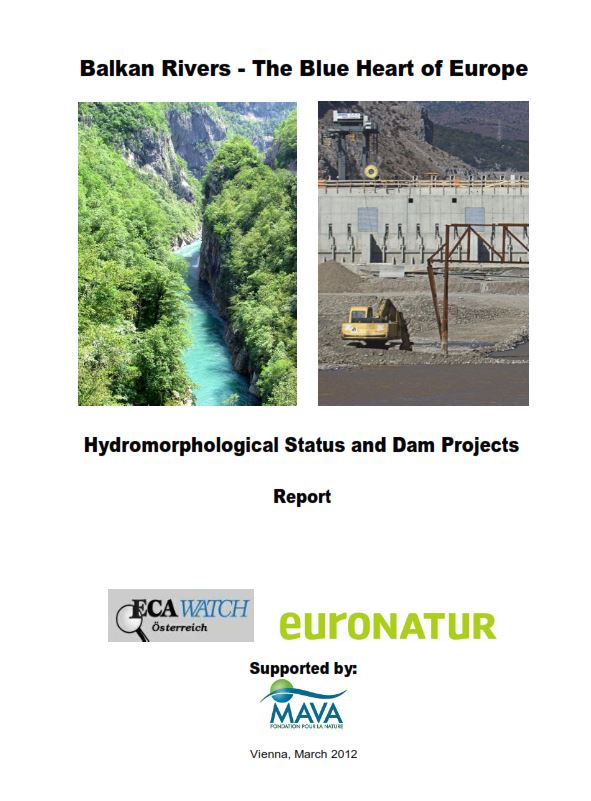 Hydromorphological Status and Dam Projects
Hydromorphological Status and Dam Projects
In preparation for this campaign, the hydromorphology (the structural intactness of the river) of about 35,000 river kilometers on the Balkan Peninsula has been assessed. The results were impressive: 30% of the Balkan rivers are in a pristine state, another 50% are in a good condition or only moderately modified. In other words, almost 80% of 35,000 river kilometres are in a very good, good or acceptable morphological condition. That is the highest percentage in all of Europe.
An extensive research was also done on the proposed and planned dam projects in the Balkan region.
Find the study about the hydromorphology and the dam projects here:
Balkan River Assessment Executive Summary
Balkan River Assessment
Balkan River Assessment River Catalogue
Also, country specials have been compiled:
| Slovenia | Croatia | Bosnia & Herzegovina | Serbia |
| Montenegro | Kosovo | Albania | Macedonia |
| Bulgaria | Greece | Turkey |
Balkan fish and molluscs
The Balkan region is Noah’s Ark for Europe. Europe’s fly fishers have known it all along, but now there is scientific proof: the Balkan region is the most important hotspot for threatened fish species in Europe. This is also true for freshwater bivalves and freshwater snails.
In his study, renowned fish expert Dr Jörg Freyhof verified the importance of Balkan rivers for Europe’s fauna. 69 fish species can only be found in the Balkan region (endemic types). 28% of endangered freshwater fish species find habitat in these rivers. The percentage is even higher in regards to bivalves and snails: over 40% of all endangered mollusc species in Europe can be found here.
Here is another fact: if the dams are being built, underwater biodiversity will be reduced drastically. 75% of all fish species and 70% of bivalves and snails would not be able to adapt to the new environment and would either die or decrease significantly in numbers.

